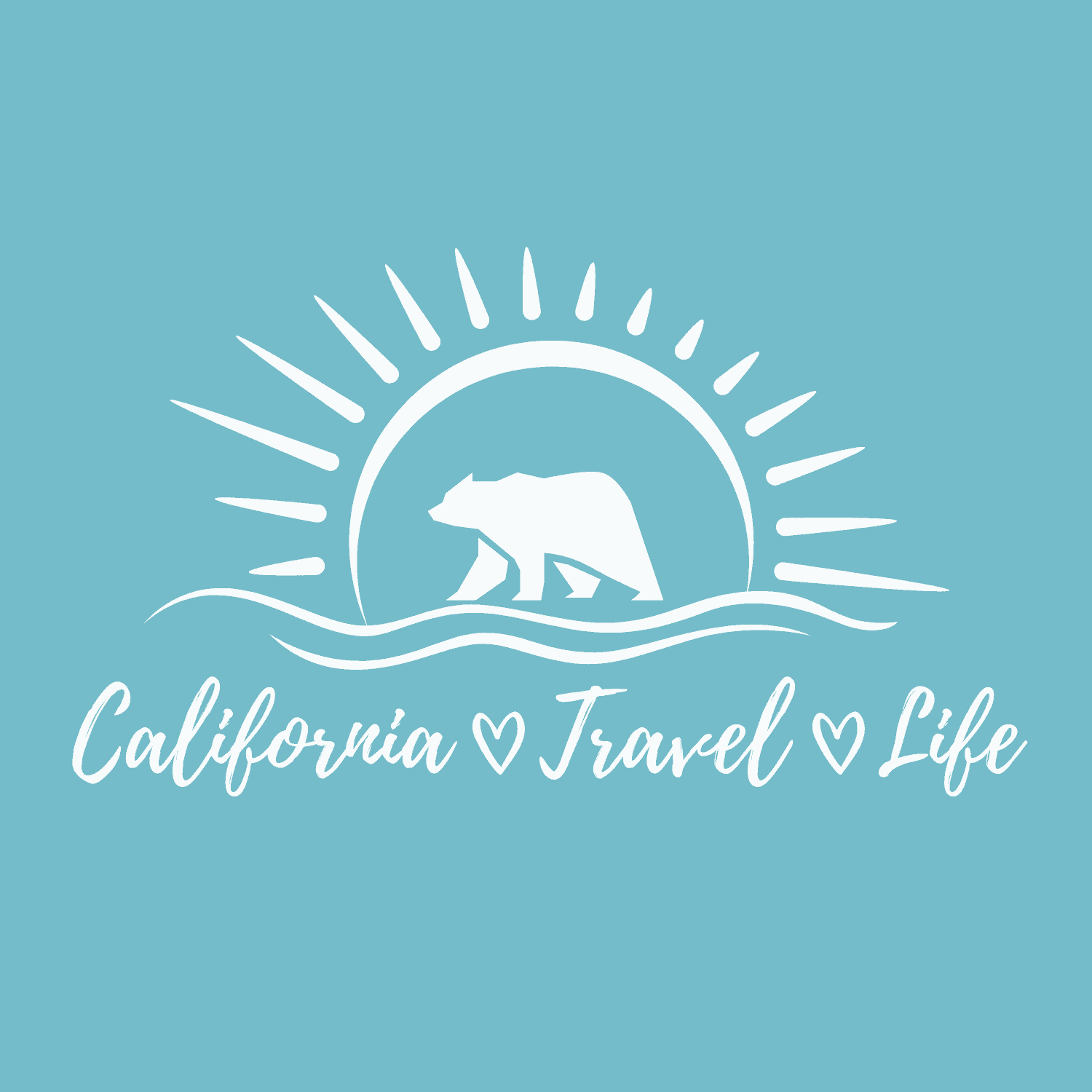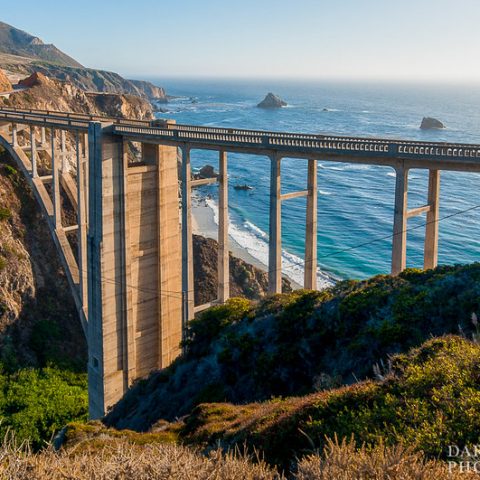California is an incredible place. It is 163,696 square miles of diverse landscapes, culture, and beauty. There is so much to see and do in the Golden State, but what are the California landmarks you really don’t want to miss?
This list of 75 California landmarks is designed to serve as a bucket list for those of us who aim to see an do it all in the Golden State!
From the remote redwoods in the northwestern reaches of the state to the deserts that dominate the southeast (and everything in between), here are 75 California icons you must see for yourself.
75 California Landmarks to Check Off Your Bucket List
1. Golden Gate Bridge
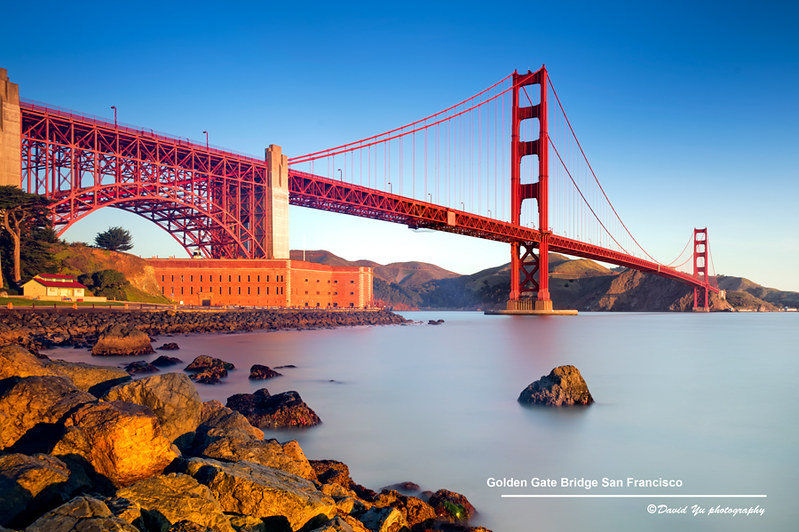
There are few California landmarks more iconic than the Golden Gate Bridge. This stunning, 2-mile suspension bridge was completed in 1937 and connects San Francisco with Marin County to the north.
It is continuously being touched up with the pain color International Orange because of the harsh impacts of the salty air on the metal structure.
The Golden Gate Bridge is California Historical Landmark No. 974.
2. Yosemite Valley

Yosemite Valley has been leaving visitors awe-struck for generations. The granite monoliths of Half Dome and El Capitan stand like skyscrapers above the Valley, while waterfalls cascade down to join the Merced River winding down below.
It is just eight miles long and one mile wide but packed into that small valley is enough beauty to inspire the likes of John Muir, Ansel Adams, and countless visitors who have stood in her presence.
Here are 16 Easy Hikes in Yosemite that you won’t want to miss when you visit. We have also put together an epic Yosemite Day Trip itinerary.
Yosemite is a National Park and Yosemite Valley is a California Historical Landmark No. 790.
3. The General Sherman Tree

General Sherman is another natural California landmark that must be witnessed in person to be fully appreciated. If you have ever wondered what it must feel like to see the world from an ant’s perspective, stand next to this tree.
General Sherman is the largest tree in the world and is located inside of Sequoia National Park’s Giant Forest. It measure 103 feet around and 275 feet high… for now. This behemoth is still growing, adding enough wood each year to make a 60-foot tree!
4. Hollywood Walk of Fame
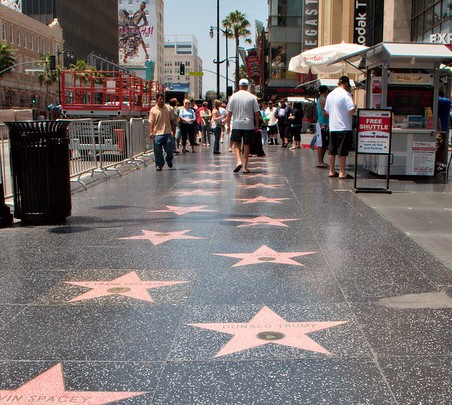
Over 10 million tourists flock to the Hollywood Walk of Fame each year to spot the stars of their favorite actors and musicians each year. The first star was placed in 1960. Today, there are over 2,500 stars on 15 blocks of Hollywood Boulevard and Vine Street.
Star maps are available, but I think it more fun to wander around and stumble upon my favorites!
5. Santa Monica Pier
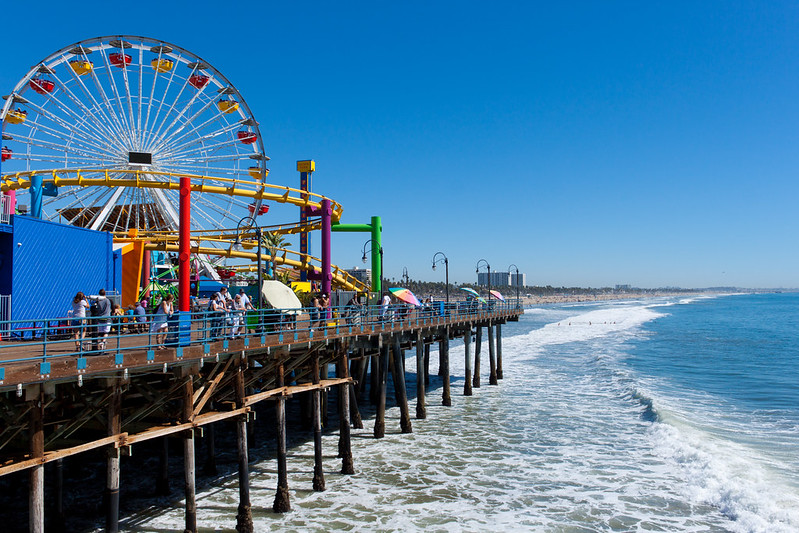
Thanks to television and movies, the Santa Monica Pier is easily one of the most recognizable California landmarks. The amusement park atop the pier opened in 1916, and still entertains over four million visitors annually with its rides, games, and street performers.
The Santa Monica Pier is located at the end of Historic Route 66! Muscle Beach is located just south of the Pier, as well as the original Hot Dog on a Stick stand.
Santa Monica Pier’s Loof Hippodrome received National Historic Landmark designation in 1987.
6. Mission San Juan Capistrano
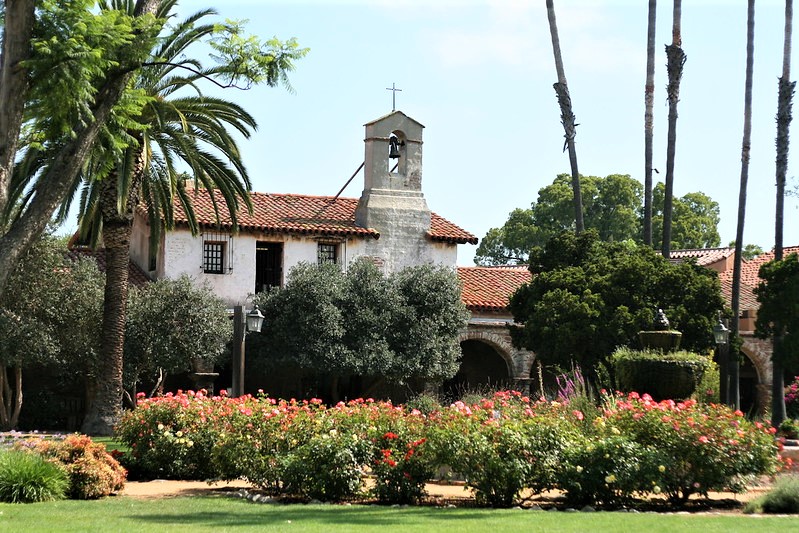
Mission San Juan Capistrano is known as the “Jewel of the Missions”. Originally founded in 1776 – the year our nation was founded- and has an iconic bell wall and well-preserved ruins.
Many people know also know Mission San Juan Capistrano as the California landmark where swallows return every year. Seeing the mission is a popular day trip by train, since the station is just across the street.
On the other side of the tracks you will find the Los Rios District, which is the oldest continuously inhabited neighborhood in California.
Mission San Juan Capistrano is California Historical Landmark No. 200
7. Sutter’s Mill and the Marshall Gold Discovery Site

California might not have been rushed to statehood in 1850 if it weren’t for that fateful day in January 1848 when gold flakes were discovered near Sutter’s Mill in Coloma by James Marshall.
The California Gold Rush brought 300,000 people from all over the world to “them thar hills”, hoping to strike it rich.
Unfortunately, few people made their fortune during the gold rush outside of bankers and storekeepers, but this piece of California history continues to captivate us.
History enthusiasts can make the pilgrimage to Coloma and see a working replica of Sutter’s Mill, the spot where gold was discovered, and several historic buildings.
They can also meet with pan for gold, watch docents working as blacksmiths, and enjoy the beautiful of the American River. Who knows, maybe you will see something sparkling in the water.
Sutter’s Mill is California Historical Landmark No. 143.
8. Hearst Castle

Hearst Castle is located high atop a hill in San Simeon, along the Central Coast. The extravagant castle belonged to famed publishing tycoon William Randolf Hearst and played host to countless celebrities during the 1920s and 30s.
The main house is 68,500 square feet with 38 bedrooms, 30 fireplaces, and 42 bathrooms. It is filled with art from all over the world, has a private theater, billiard room, library, and three guest houses. There are over 70,000 trees planted on the grounds.
The Neptune Pool, filled with beautiful intricate tiles, took over 15 years to build. Why? Because it took three different attempts before Hearst was finally satisfied with the design. This is one of those California landmarks that truly must be seen to believed.
Tip: Keep your eyes out for zebras on the hillsides near Hearst Castle. They are descendants of those who were once part of Hearst’s private zoo.
9. Alcatraz

Alcatraz, aka The Rock, sits on a lonely island surrounded by the freezing, shark infested waters of the San Francisco Bay. Over 1500 inmates called this prison home during the 29 years that it served as a penitentiary.
Alcatraz was the place to send inmates who weren’t behaving in other California prisons, especially those who were known to be escape artists. Famous names who were sentenced to time in Alcatraz include Whitey Bulger, Machine Gun Kelly, and Al Capone.
Ultimately, it was just too cost prohibitive to continue to operate Alcatraz as a prison, and it was eventually turned over to the National Park Service. Today, visitors can take guided tours of the prison, check out the tiny cells for themselves, and learn about the colorful history of this special place.
Alcatraz was added to the National Register of Historic Places in 1976.
4. Catalina’s Casino
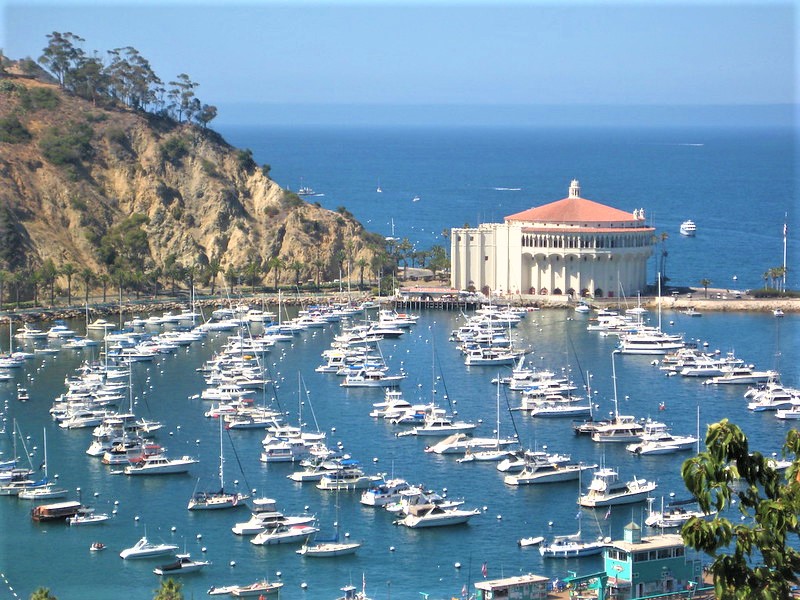
When I was growing up and watching the weather report on Today in LA before school, I remember often seeing a live shot of the Catalina Casino before the weather report began. It always looked so glamorous and far away, although it was just a one-hour ferry ride from Long Beach.
I never did make it to Catalina as a kid, but I have taken my own family for weekend getaways on multiple occasions. On Catalina, golf carts far outnumber cars, and life moves at a more relaxed and carefree pace. It truly feels like you are a world away from the hustle and bustle of LA.
The Catalina Casino is not a gambling house. Built in the late 1920s, this 11-story circular fixture on Avalon Harbor is an entertainment venue. Its ballroom hosts events throughout the year and its theater shows movies.
5. The Presidio of San Francisco
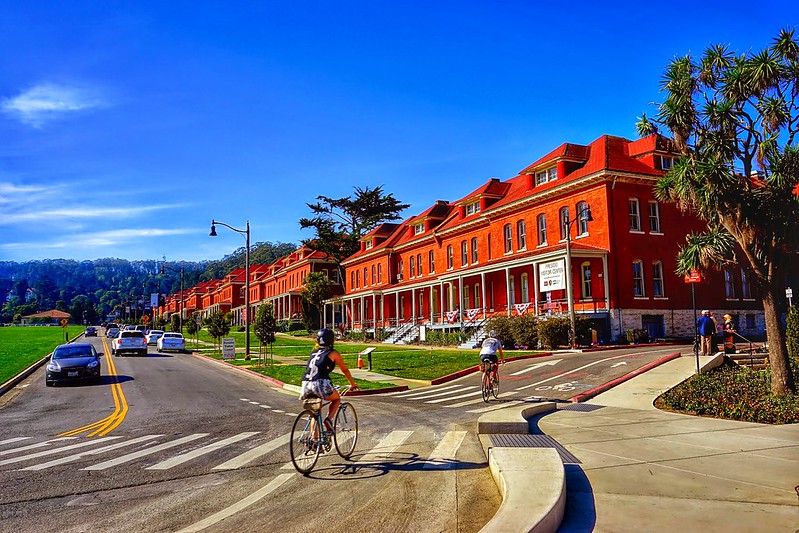
The San Francisco Presidio was first built in 1776 and was used by a military base for over 218 years by the Spanish, Mexican, and American armies during that time. In 1994, ownership was transferred to the National Park Service and has become a tourist attraction.
There are 24 miles of hiking and biking trails inside the Presidio, as well as the only overnight campsite in all of San Francisco, located in an eucalyptus grove above Baker Beach. It is also home to 470 historic buildings, as well as the Walt Disney Museum.
The Presidio is a National Historic Landmark District and California Historical Landmark no. 79.
6. Burney Falls
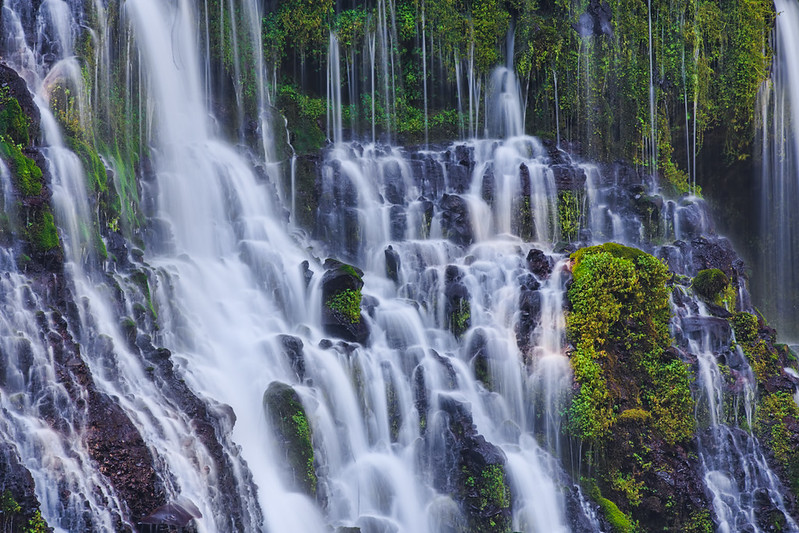
Burney Falls is not the tallest waterfall in California (that honor goes to Yosemite Falls) but it is certainly one of the most beautiful. It is located in California’s scantly-visited northeastern corner, about 65 miles east of Redding.
The 129-foot waterfall is fed by underground springs, resulting in a weeping wall of water. It is a site so beautiful that President Theodore Roosevelt once called it the “eight wonder of the world”.
Visitors to Burney Falls will enjoy area trails, great camping, and plenty of opportunity for water play at Lake Britton which borders McArthur-Burney Falls State Park.
7. Manzanar National Historic Site
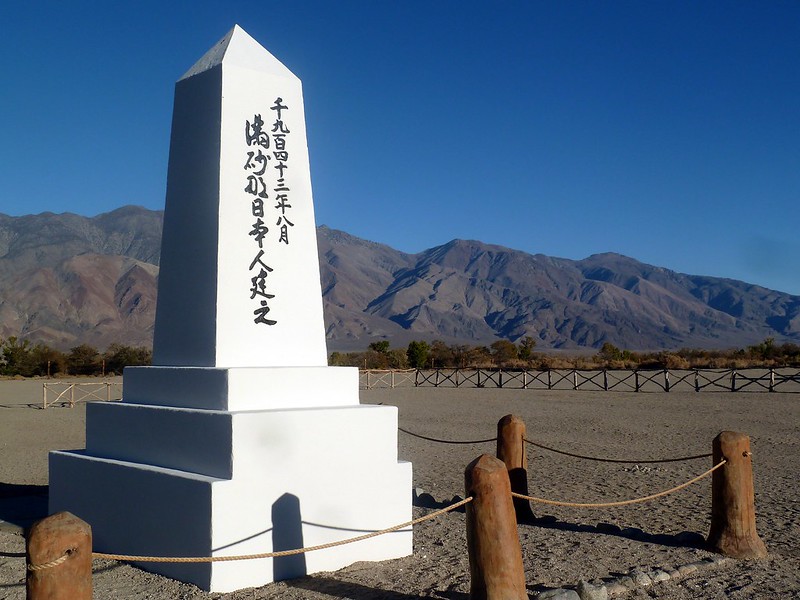
In 1942, the United States government ordered more than 110,000 Japanese American men, women, and children to leave their homes and be placed in military-style camps. Manzanar War Relocation Center, located near Owens Valley off lonely Highway 395, was one of these camps.
This is a chapter in American history that nobody should be proud of, and many aren’t even aware of. But it is important to learn about the mistakes of our nation’s past and honor those who were forced to leave their homes and live like prisoners.
Manzanar National Historic Site is operated by the National Park Service. Guided tours are led by park rangers but self-guided experiences are available as well. There are two reconstructed barracks, a reconstructed women’s latrine, and a remodeled WWII era mess hall.
Manzanar is California Historical Landmark No. 850.
8. Sutter’s Fort

Sutter’s Fort was built by John Sutter in 1841. It was meant to be the trade and commerce center of the Sacramento Valley. Several pioneers lived inside the fort during the early 1840s and the city of Sacramento was built around it.
During the winter of 1847, residents of Sutter’s Fort formed rescue parties to rescue the legendary Donner Party. Sutter’s Fort is also associated with the gold rush because it is where James Marshall let Sutter know about the discovery of gold at Sutter’s sawmill.
Unfortunately, the gold rush led to the desertion and destruction of the fort by miners looking to harvest its resources before heading out to the gold mines.
Today, Sutter’s Fort State Historic Park is open for self-guided tours. Much of the fort has be reconstructed and highlights what life was like inside the fort during the 1840s.
Sutter’s Fort was designated a National Historic Landmark in 1961 and is California Historical Landmark No. 525.
9. California State Capitol

California became a state in 1850 but the State Capitol building was not completed until 1874. It is a grand Neoclassical building and its architecture was inspired by the US Capitol building in Washington DC.
Visitors can tour portions of the building that are open to the public on a guided tour or via a self-guided walk around the grounds. The 40-acre park surrounding the capitol is filled with trees from around the world and is especially beautiful in the fall when autumn leaves are brilliant shades of red, gold, and orange.
The California State Capitol was added to the National Register of Historic Places in 1973 and is California Historical Landmark No. 872.
10. Calistoga’s Petrified Forest and Old Faithful Geyser
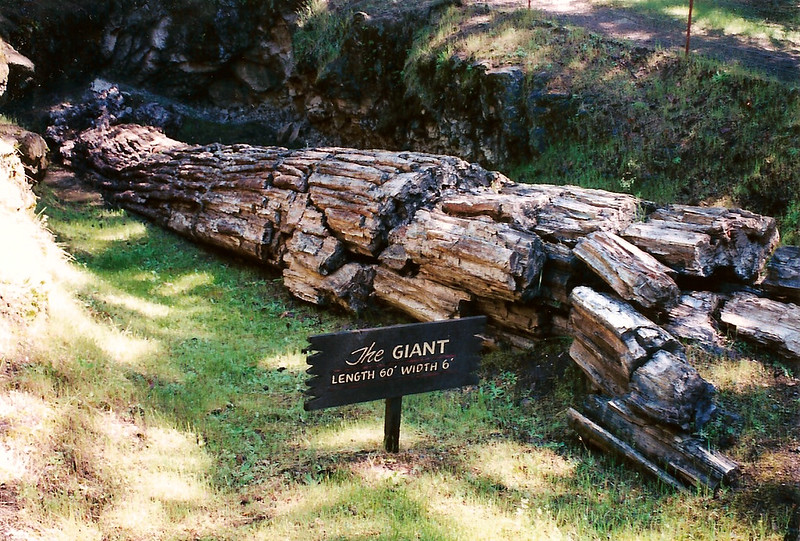
Did you know that California has its very own petrified forest and an Old Faithful geyser that erupts every 15-30 minutes? Both are located in Calistoga, in Sonoma County’s Wine Country.
The geyser is open daily, and in addition to the geyser’s eruption, visitors will enjoy the petting zoo which has llamas, sheep, and goats. The goats are supposedly “fainting” goats, but don’t seem to faint very often these days.
The California Petrified Forest is home to the largest petrified trees in the world! They are fossilized redwood trees that were excavated after laying beneath volcanic ash for millions of years. The volcanic ash is the result of an explosion of Mt. Saint Helena eons ago, which knocked down the redwood forest.
The Petrified Forest is privately owned but open for visitors. There are trails that allow you to take a self-guided journey through the forest and admire these ancient giants.
The Petrified Forest is California Historical Landmark No. 915.
11. Santa Cruz Beach Boardwalk
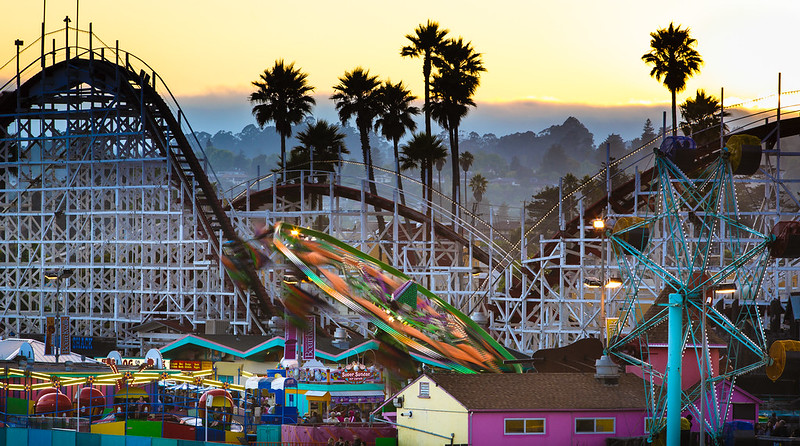
Everyone who grew up in the Bay Area is familiar with the Santa Cruz Boardwalk. It was a place to escape the heat of summer, enjoy a day at the beach, eat half your body weight in hot dogs and funnel cake, and enjoy carnival rides and games.
A visit to the Boardwalk is definitely an essential California experience. It is the only major seaside amusement park that is still operating on the West Coast. There are over 40 rides and attractions on the Boardwalk, including midway games, an indoor mini-golf course, laser tag, and arcades.
Ride highlights include throwing rings into the giant clowns mouth from the historic Loof Carousel and riding the famed Giant Dipper roller coaster. Both became National Historic Landmarks in 1987.
The Santa Cruz Beach Boardwalk is California Historical Landmark No. 983.
Santa Cruz made our list of the best Northern California weekend getaways. See what other special places made the list!
12. The Mystery Spot

The Mystery Spot is a classic California roadside attraction that has been around since 1941. In the Mystery Spot, the laws of gravity and physics seem to disappear.
Tour guides speculate that it was an ancient meteor that left a “magic circle” or that cones of metal were secretly buried to act as guidance for spacecraft.
In actuality, the Mystery Spot is a tilt-induced visual illusion. The house is slanted at a 20-degree angle, allowing people to stand crooked on chairs and balls to seem to roll uphill.
Whatever the reason, the experience if witnessing the wonders of the Mystery Spot is tons of fun, especially with young kids who haven’t visited before.
The Mystery Spot is California Historical Landmark No. 1055.
13. Trees of Mystery
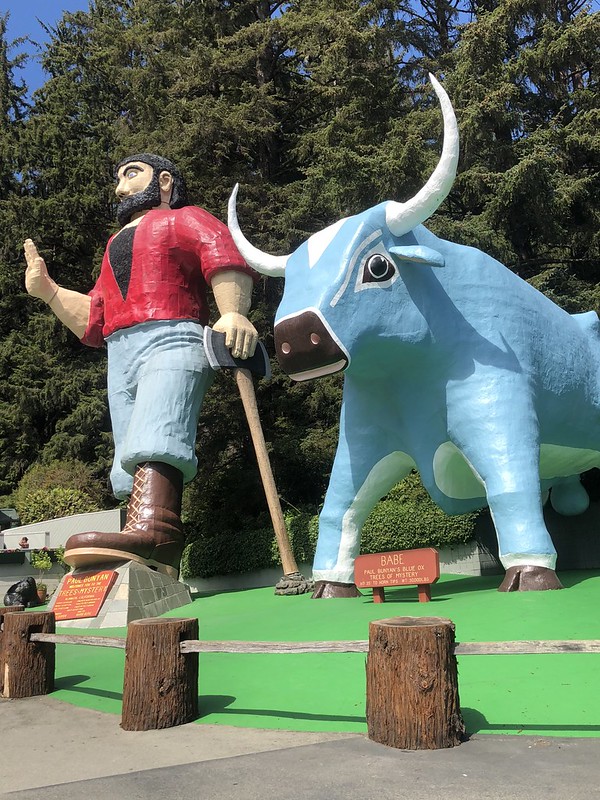
Another roadside attraction that has joined the ranks of other California landmarks is the Trees of Mystery in Klamath, near Redwood National Park.
It is known for its aerial tramway, as well as its trails filled with unusual tree formations and 50 different chainsaw sculptures. It is most famous for Paul Bunyan and his Blue Ox, Babe. Paul Bunyan stands 49 feet high and Babe the Blue Ox is 35 feet alongside him and both can be spotted from Highway 101.
14. Winchester Mystery House
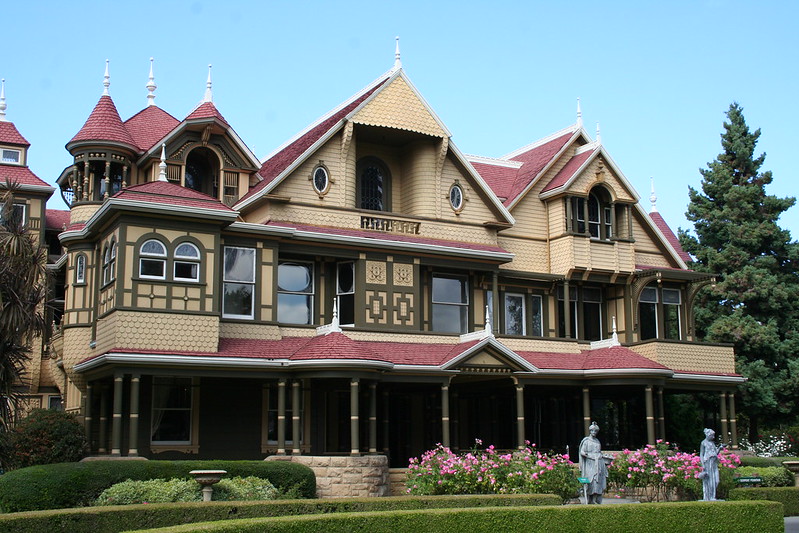
The Winchester Mystery House is an extraordinary maze of Victorian craftsmanship. The home is infamous for staircases that lead to nowhere, doors that open into walls, and its 160 rooms.
The houses oddities were built to throw off the spirits following Sarah Winchester, wife of the Winchester rifle heir. She had lost her husband and only child and many believe her constant home remodeling was fueled by superstition as well as grief.
Today, the massive mansion is open for tours which are especially popular during Halloween and Christmas. Many visitors report experiencing paranormal activity.
The Winchester House is California Historical Landmark No. 868.
15. Mission Santa Barbara
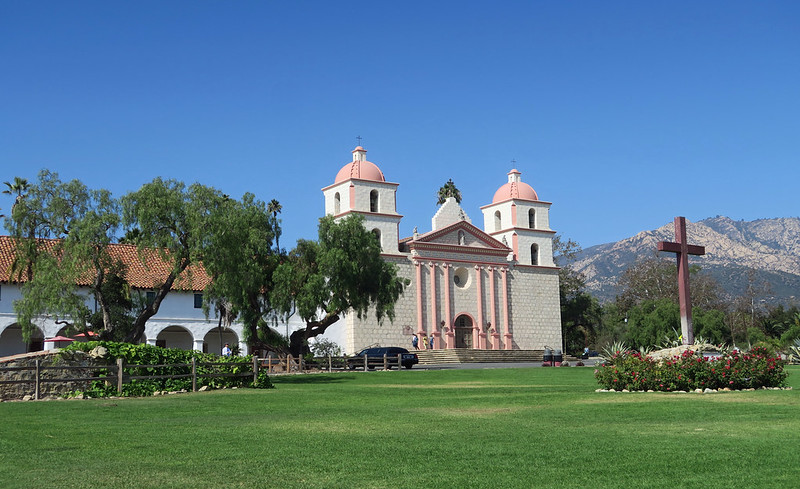
There are 21 missions along California’s historic mission trail, El Camino Real, but Mission Santa Barbara is definitely one of the most popular to visit. It was founded in 1786 and is the only mission to be continuously operated by the Franciscans since its founding.
Mission Santa Barbara is called “The Queen of Missions” because it is the most beautiful and best preserved. Juana María, the lead character in Island of the Blue Dolphins was buried at the mission cemetery in 1853.
Today, visitors can tour the garden, cemetery, mission church, and museum.
Mission Santa Barbara has been a US National Historic Landmark since 1960 and is California Historical Landmark No. 309.
16. Stearns Wharf
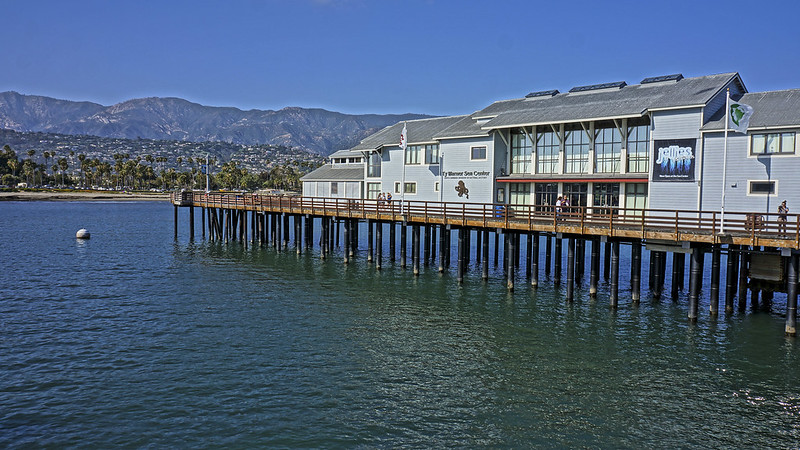
Stearns Wharf, on the Santa Barbara waterfront, is the oldest working wooden wharf in California. It was built in 1872 by John Peck Stearns in order to help facilitate the movement of people and cargo from ship to shore.
These days, Stearns Wharf is a hub of tourist activity. Shops, restaurants, and the Santa Barbara Museum of Natural History Sea Center are the main draws, as well fabulous views of Santa Barbara’s coast and mountains.
17. Point Bonita Lighthouse

During the Gold Rush, over 300 boats ran aground as they tried to enter the San Francisco Bay via the famed- and often foggy- Golden Gate. Thus, the Point Bonita Lighthouse was built in 1855.
It is perched on a perilous spot in the Marin Headlands, and is the only lighthouse in the US that is reached by walking over a suspension bridge. The trail down to the Lighthouse offers great views of the Golden Gate Bridge and surrounding area.
Visitors are allowed to cross the suspension bridge and visit the lighthouse on Sundays and Mondays from 12:30 -3:30pm. The trail to the lighthouse includes a walk through a tunnel carved into the hillside, which is pretty cool!
Point Bonita Lighthouse was added to the National Register of Historic Places in 1991.
18. Bixby Bridge

The drive along California’s Big Sur coastline is one of the most beautiful on the planet. It is 85 miles of pure scenic bliss, and just when you think the views have peeked at one turn of the road, it turns again and you discover an even better view.
Completing this rugged stretch of Highway 1 was no easy feat. The greatest engineering marvel along this drive is the iconic Bixby Bridge. It was completed in 1932 and stands 260 above Bixby Creek.
Bixby Bridge is one of the highest single-span arch bridges in the world, and is incredibly popular to photograph.
19. Morro Rock

One of the most well-known natural California landmarks on the Central Coast is Morro Rock. It is a remnant of an extinct volcano that sits at the mouth of Morro Bay, and is 581 feet tall.
It is a nesting ground for several bird species, including the peregrine falcon. Seals, sea lions, and sea otters are often spotted in the water around Morro Rock. You can use the Harborwalk Trail to visit the rock or kayak out onto the calm bay and enjoy it (and the sea mammals) from the water.
Morro Rock is is California Historic Landmark no 821.
20. Coit Tower
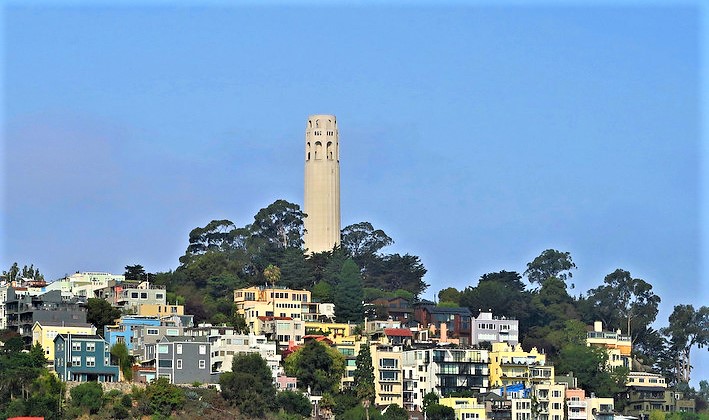
Coit Tower is another iconic structure found in San Francisco. This concrete Art Deco tower sits atop Telegraph Hill in Pioneer Park.
The 210-foot building was built in the 1930s and is named for Lillie Hitchcock Coit, a San Francisco philanthropist who left a third of her fortune to the city of San Francisco with instructions “to be expended in an appropriate manner for the purpose of adding to the beauty of the city which I have always loved.”
Inside Coit Tower there are 27 murals created by 26 artists, making it the largest collection of Public Works Art Project art in the country. The murals were not created without controversy. Some of the original had Communist symbols which were painted over.
Most visitors to Coit Tower come for the view which include the Financial District, Nob Hill, Lombard Street, Pier 39 and the Ferry Building, Angel Island, Alcatraz, and both the Golden Gate and Bay Bridges.
Coit Tower was added to the National Register of Historic Places in 2007 and became a National Historic Landmark in 2008.
21. Point Loma Lighthouse and Cabrillo National Monument

On the southern tip of the Point Loma Peninsula in San Diego are two important California landmarks, the Old Point Loma Lighthouse and Cabrillo National Monument.
Old Point Loma Lighthouse was one of the eight original lighthouse built on the West Coast. It was commission in 1855 and decommissioned in 1891. Its location 422 feet above sea level meant fog often obscured the light so a replacement lighthouse closer to sea level had to be built.
Today, visitors can go inside the lighthouse as well as visit Cabrillo National Monument which is the same location. This monument was built in 1913 to honor Juan Rodriguez Cabrillo who landed at the San Diego Bay back on September 28, 1542. He was the first European to set foot on the West Coast.
Prime time to visit this area is December through March, when gray whales can often be spotted off Point Loma during the migration to and from their birthing grounds off the coast of Mexico. There are also some nice tide pools to explore. No matter the time of year, the views of San Diego and its harbor are spectacular.
Point Loma is California Historical Landmark No. 51 and Cabrillo National Monument is California Historical Landmark No. 56.
22. Antelope Valley Poppy Fields
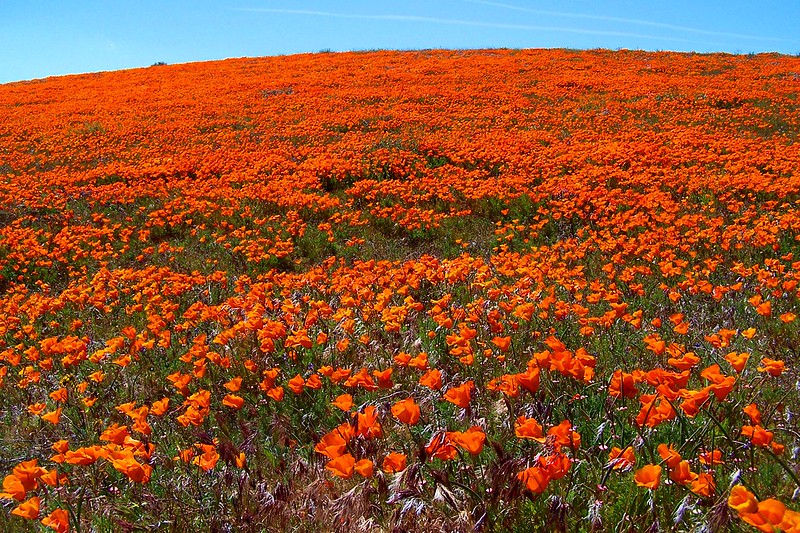
The California poppy is our state flower, and it can be found en masse at the Antelope Valley California Poppy Reserve during the spring bloom. The wildflower blooming season is dependent on rainfall, but typically take place mid-February through May.
There are eight miles of trails to enjoy and several benches to stop at along the way. Remember, look at but don’t touch these delicate flowers.
23. San Andreas Fault

The San Andreas fault is definitely the most famous fault in all of California. It runs for 800 miles, from the Salton Sea to Cape Mendocino. When it ruptures, it has the potential to trigger an earthquake magnitude 8.0 or higher!
None of us in California are really fans of the San Andreas fault, but we are certainly fascinated by it. One great way to see the San Andreas fault and learn about it is to take a San Andreas Fault Jeep Tour with Red Jeep Tours in the Coachella Valley.
This great tour is led by a naturalist who takes you to geologic cuts and canyons created by the San Andreas fault while teaching tour-goers about the geology, seismology, flora, and fauna of the region.
24. California’s Lowest Point (Death Valley)
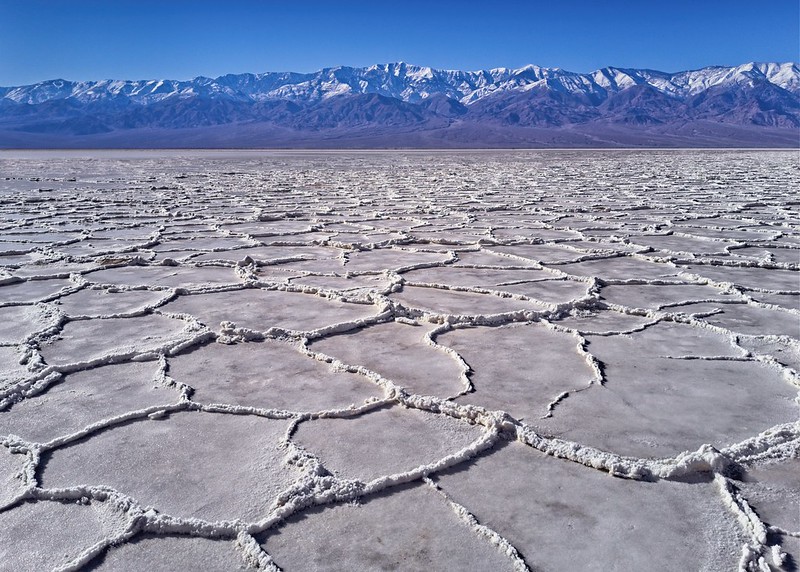
California is a large state filled with extremes. The lowest point in California (and all of North America) is Badwater Basin in Death Valley National Park. It is 282 feet below sea level!
Badwater Basin is an extremely inhospitable place, named for the spring that produces undrinkable water which pools to form a shallow pond.
There is a thick layer of salt on the floor of Badwater Basin which is formed by temporary lakes that settle in after a heavy (and extremely rare) rainstorm. When the water evaporates, mineral salts are left behind.
Trekaroo has a great guide on things to do in Death Valley.
25. California’s Highest Point (Mt. Whitney)
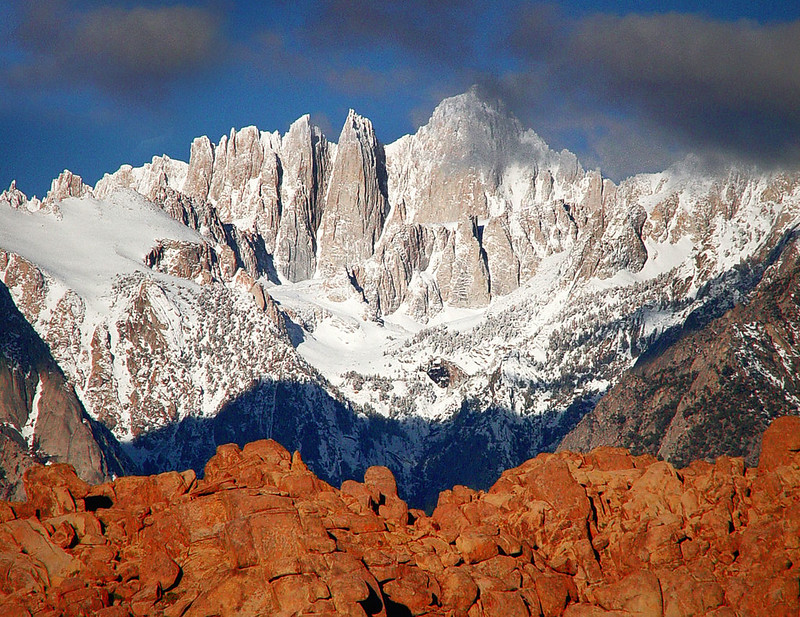
76 miles from Badwater Basin is Mount Whitney, the highest point in California, and the continental USA. It soars at 14,501 feet in height in the rugged southern Sierra Nevada mountain range.
Mt. Whitney does border Sequoia National Park, but nearly everyone accesses the mountain via the town of Lone Pine off Highway 395. The trail to the top is 22 miles round trip and gains 6130 feet in elevation along the way.
In order to make the strenuous hike to the top you must secure a permit in the permit lottery held by the US Forest Service.
26. California’s Easternmost Point (3 Miles South of Parker Dam)

We’ve covered the highest and lowest, but what about north, south, east, and west?
Let’s begin with the easternmost spot in California, a spot not generally considered when people think about a state the occupies for more latitude than longitude.
Technically, the most eastern spot in California can be found out in the middle of the Colorado River about three miles south of Parker Dam. So, if you make it to Parker Dam, let’s call it close enough!
Parker Dam is the concrete structure that holds back Lake Havasu. This area is a popular vacation destination for boaters.
27. California’s Westernmost Point (Cape Mendocino)
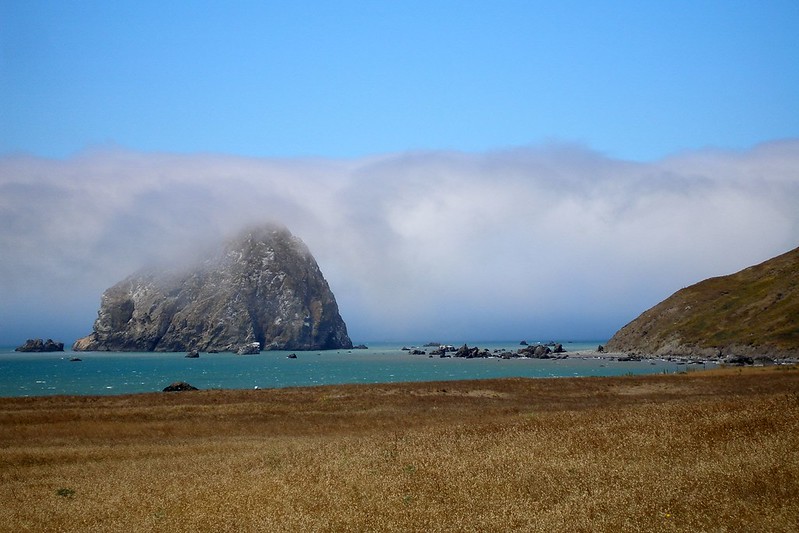
While all of the western edge of California hugs the Pacific, the most western reaches of the state can be found at Cape Mendocino in Northern California. Yep, that same Cape Mendocino where the San Andreas fault makes its way out into the ocean. No surprise, it is quite seismically active.
This is a wild and remote section of coastline known as the Lost Coast. The closest town is tiny Petrolia, which earned its name for being the first place an oil well was drilled in California.
28. California’s Southernmost Point (Border Field State Park)
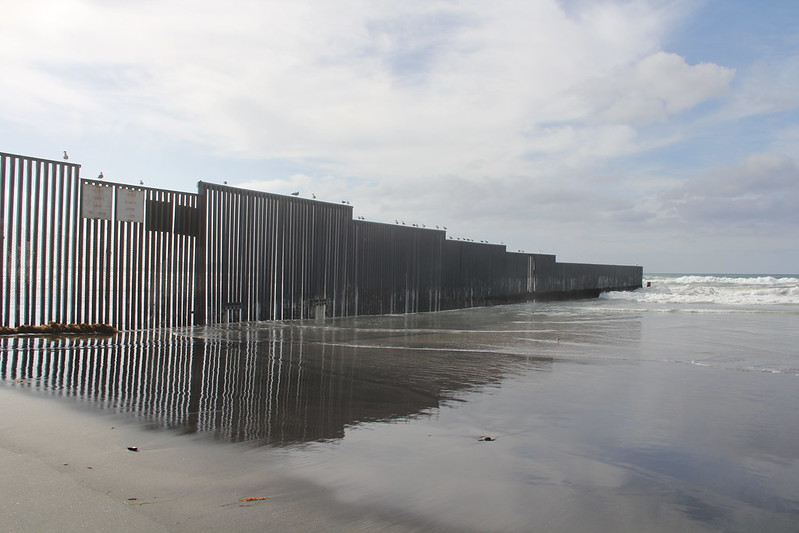
California’s southernmost point is the border that it shares with Mexico, specifically at Border Field State Park in Imperial Beach, California. This spot is within the Tijuana River National Estuarine Research Reserve which provides habitat for threatened and endangered birds.
The beach here is usually uncrowded, and a nice place to hike and view wildlife, but not a good place to swim. It is, however, a good place to see the infamous border wall for yourself.
29. California’s Northernmost Point (42nd Parallel)

It is no surprise to anyone with geography knowledge that California’s northernmost point is the border that it shares with Oregon. The entire border runs along the 42nd Parallel, so any spot along this border qualifies as “the northernmost”.
It is easiest to reach this point via California’s major north/south highways- Interstate 5 and Highway 101. Highway 101 offers the beaches and redwoods, while the portion of Interstate 5 that cross the border is forested but not as lush. There are several other crossing highways along the border, but any route you choose will be rural.
30. Palm Springs Aerial Tramway
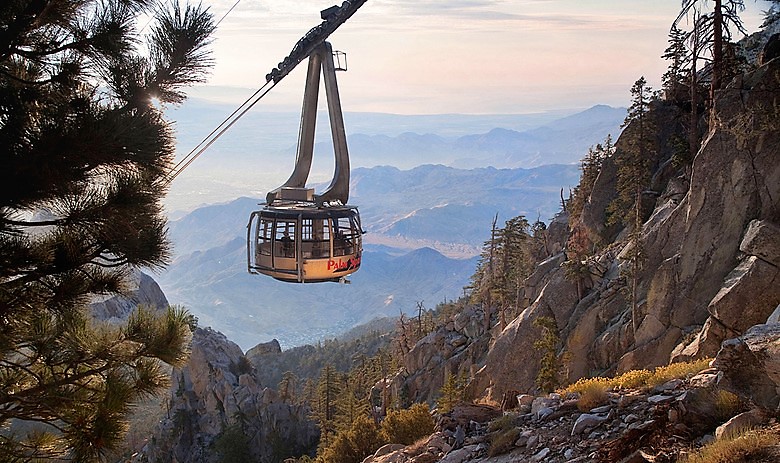
The Palm Springs Aerial Tramway is the world’s largest rotating tramcar. It begins at the base of Chino Canyon at 2,643 feet and carries passengers up the steep mountainside to the station Mountain Station at 8,561 feet. The ride to the top takes about 10 minutes.
The weather at the Mountain Station is 30-40 degrees cooler than on the valley floor, making it a really fun and unique experience. Where else can you from lounging by the pool to playing in the snow in less than an hour?
31. Mono Lake
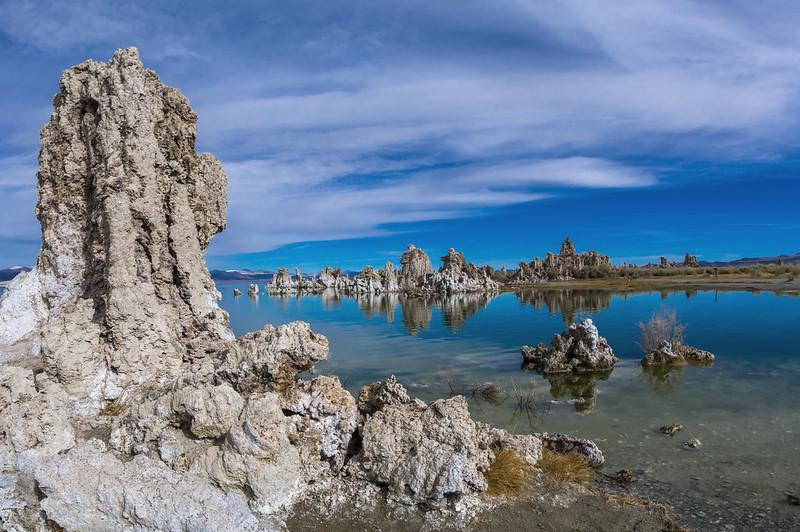
Mono Lake is a weird place. It is an ancient lake with large tufa formations sprouting out of its waters and is twice as salty as the ocean.
Tufas are calcium-carbonate pillars and knobs of varying heights and sizes that protrude from the lake’s surface. They’re formed by the interaction of freshwater springs and alkaline lake water.
The best way to experience the lake is to either take a free, guided tufa walk or a guided kayak tour. Both are led by naturalists which can answer all your questions about this unique spot, including those about the massive migratory bird population that calls the lake home seasonally.
32. Bodie Ghost Town

Not too far from Mono Lake is Bodie, Bodie, a California gold mining era ghost town. It is fun to wander the town’s abandoned streets and witness a town in the state of “arrested decay”.
At its boom during the Comstock Lode gold strike in 1879, Bodie had a population of 10,000. By 1915, it had become a ghost town.
Today, only a small portion of the town still exists but this portion still look as if the residents left moments ago. There is a wheel barrow dumped over in a yard, cups left on tables, and a tricycle parked on a porch.
Bodie State Historic Park is California Historical Landmark No. 341 and a National Historic Landmark.
33. Old Sacramento

Old Sacramento is a historic eight-block section of the city along the Sacramento River next to downtown. It is a popular tourist destination where folks can take horse-drawn carriage rides past several historic buildings.
Along raised wooden sidewalks are entrances to souvenir shops, old-fashioned candy stores, and restaurants. Other big draws to this area are the California State Railroad Museum, riverboat rides, and historic train rides.
The Old Sacramento Historic District is California Historic Landmark no. 812 and a US National Historic Landmark District.
34. Mission Inn Hotel & Spa
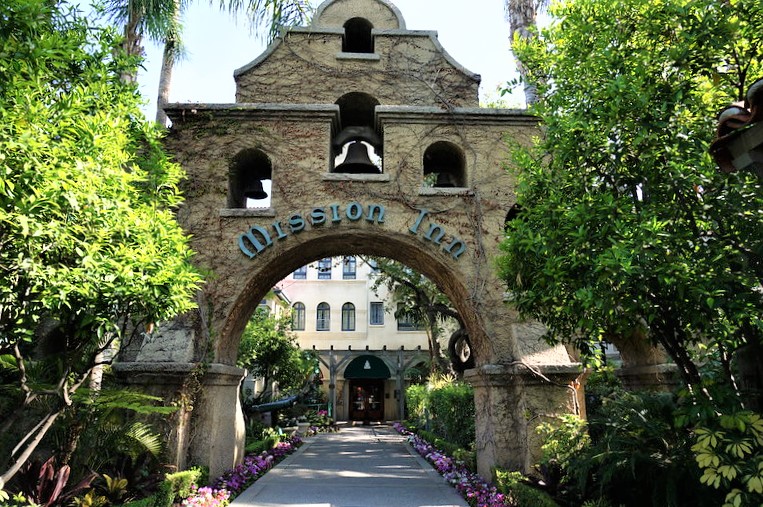
The Mission Inn Hotel & Spa in Riverside is the jewel of the Inland Empire. It was founded in 1876 as nothing more than an adobe boarding house, but by the early 1900s it became a full-service hotel catering to wealthy travelers from Back East.
Mission Inn’s architecture is Mission-Revival style and incorporates architectural features from more than 20 different California missions. It also houses artwork and furniture from around the world, as well as a bell that dates back to 1247. The Inn has hosted several US Presidents and celebrities throughout the years.
The best time of year to visit the Mission Inn is during the Festival of Lights which takes place every holiday season. People come from all around to enjoy thousands of lights and decorations, visits with Santa, carolers, horse-drawn carriage rides, and even live reindeer!
The Mission Inn Hotel & Spa is California Historical Landmark no. 761 and was designated a National Historic Landmark in 1977.
35. Empire Mine

The Empire Mine is known for being one of the largest and richest gold mines in California. It is located near Grass Valley, and operated for over 100 years between 1850 and 1956. During that time, 5.8 million ounces of gold were pulled from 367 miles of underground passages.
According to geologists, only about 20% of the gold in the mine has been recovered. A mining company still owns the mining rights down below but the surface has been turned into a state park.
The park’s museum has a scale model of the the mine’s tunnels, along with ore samples and a collection of minerals.
The Bourne Mansion is also part of Empire Mine State Historic Park. It was built entirely from the rock pulled out from the mine. This English country lodge has 13 acres of gardens and a reflecting pool.
On weekends during the high season (May through October) volunteers dress up in Edwardian clothing giving tours.
Empire Mine is California Historic Landmark no. 298.
36. Charles Krug Winery
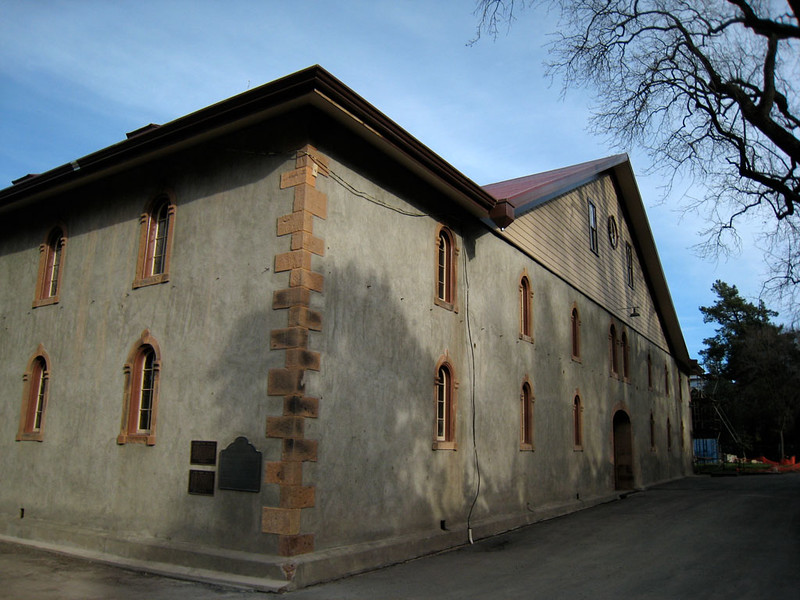
The Napa Valley is one of the most famous wine-growing regions in the world. There are over 800 wineries all over the region, but the first person to establish a winery in the region was Charles Krug, back in 1861 in Saint Helena. Krug was an innovator and true industry pioneer.
The winery was purchased by the Mondavi family in 1943 and has been operating the oldest winery and tasting facility in California ever since. The Redwood Cellar Tasting Room was originally built in 1872 and is a National Historic Landmark. It is a lovely spot for wine tasting.
Charles Krug Winery is California Historic Landmark no. 563.
37. Lava Beds National Monument
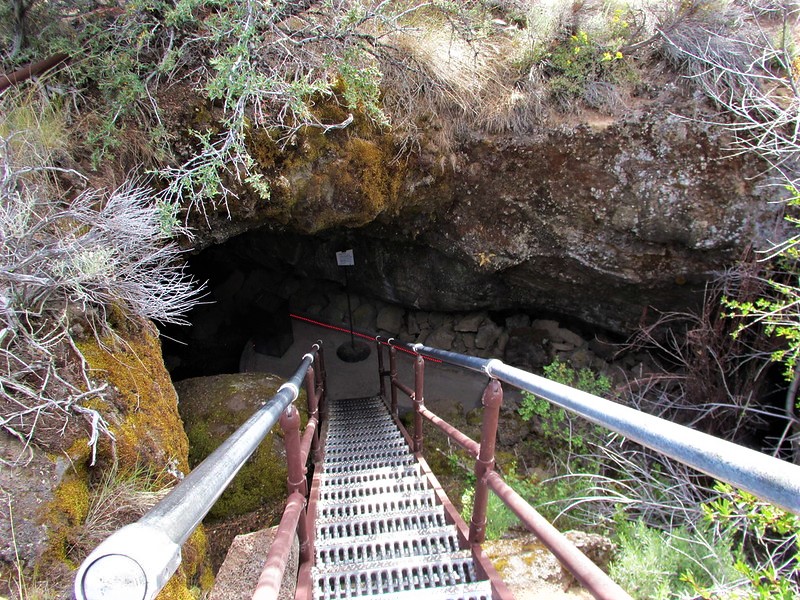
Lava Beds National Monument is a remote park in the far northeastern corner of California. It is home to the largest concentration of lava tubes in North America. Lava rocks and scrub brush dominate the scene above ground, but below ground is wear the main attractions reside.
There are lots of great caves you can explore on your own. Favorites include the ice floor of Skull Cave, beautiful Valentine Cave, and the life growing inside of Sunshine Cave.
Be sure to bring flashlights and sweatshirts because even though the weather can be warm on the surface, things cool off quite a bit below ground. Helmets and flashlights can be rented from the visitor center.
38. Hollywood Sign
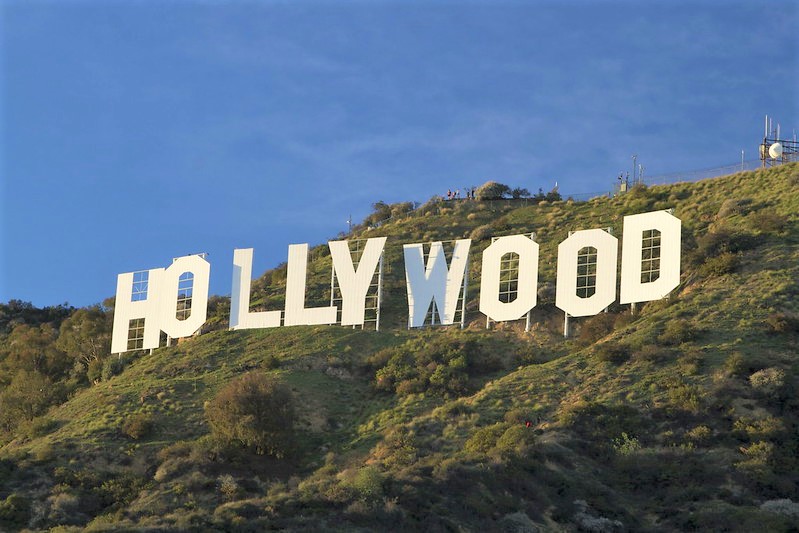
One of the most famous and iconic California landmarks is most definitely the Hollywood sign. It was originally built to be nothing more than a giant advertisement for a new real estate development, Hollywoodland. The sign rapidly became a tourist attraction and emblem of the glitz of Hollywood.
You can’t actually touch the massive, 45-foot letters, but you can get close. There are a couple different trails which will lead you to the backside of the Hollywood sign, with great views of it along the way. It is even possible to hike from the Griffith Observatory to the Hollywood Sign.
The Hollywood Sign was designated a Los Angeles Historic-Cultural Monument in 1973.
39. Griffith Observatory
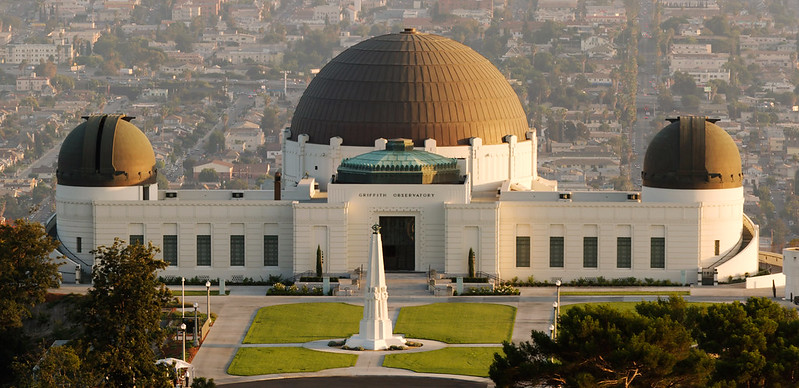
Speaking of the Griffith Observatory… It most certainly deserves a spot in this list of California landmarks! Located in Griffith Park, the Griffith Observatory is the place to visit after a good rainstorm.
The skies clear up and it is easy to see the ocean, downtown, the LA Basin, the San Gabriel Mountains, and even all the way out towards Mount San Jacinto near Palm Springs! Inside the Griffith Observatory you will find great astronomy exhibits, the historic Zeiss telescope, and a planetarium.
The Griffith Observatory was designated a Los Angeles Historic-Cultural Monument in 1976.
40. Bumpass Hell in Lassen Volcanic National Park
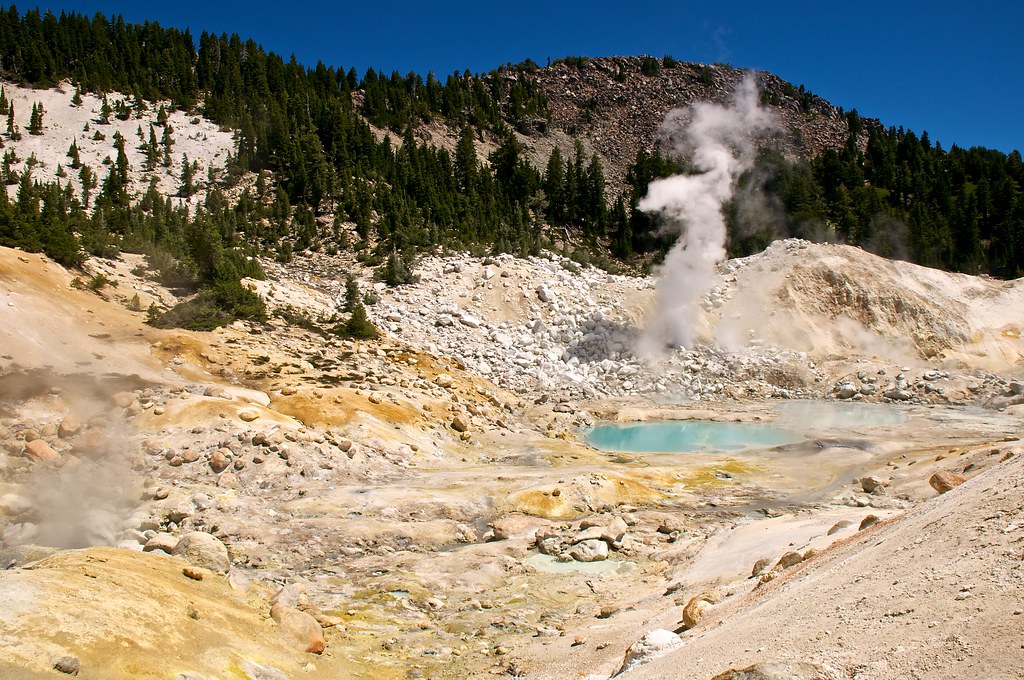
One of the most unique hikes in all of California is the hike into Bumpass Hell at Lassen Volcanic National Park. This 3-mile, roundtrip hike descends into a Lassen’s most active geothermal area filled with sulfur-scented hot springs, fumaroles, and bubbling mud pots.
Bumpass Hell was named for a cowboy named Kendall Bumpass who lost his leg after his foot broke through the thin dirt crust and his leg went into one of the boiling mud pits! Thankfully, the area is safe to explore now as long as you follow the rules and stay on the boardwalk.
41. Salvation Mountain
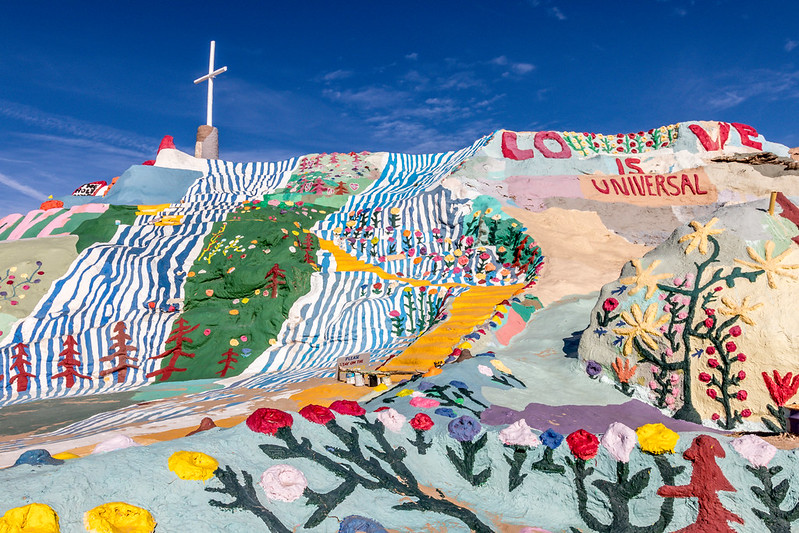
The California desert has always been a refuge for unique individuals. There are several California landmarks out there that celebrate the creativity and vision of of those who think outside the box.
Salvation Mountain is the brainchild of Leonard Knight, a self-described “visionary American folk artist’. He built a mountain east of the Salton Sea out of adobe bricks mixed with straw and sprinkled in with old tires and car parts.
The mountain is covered with several murals with Bible verses and other Christian sayings which were created with thousands of gallons of paint, much of it donated.
Knight faced health issues in 2011 which ended his work on Salvation Mountain, and he passed away in 2014. Today, a non-profit group works to maintain the mountain.
42. Mt. Diablo
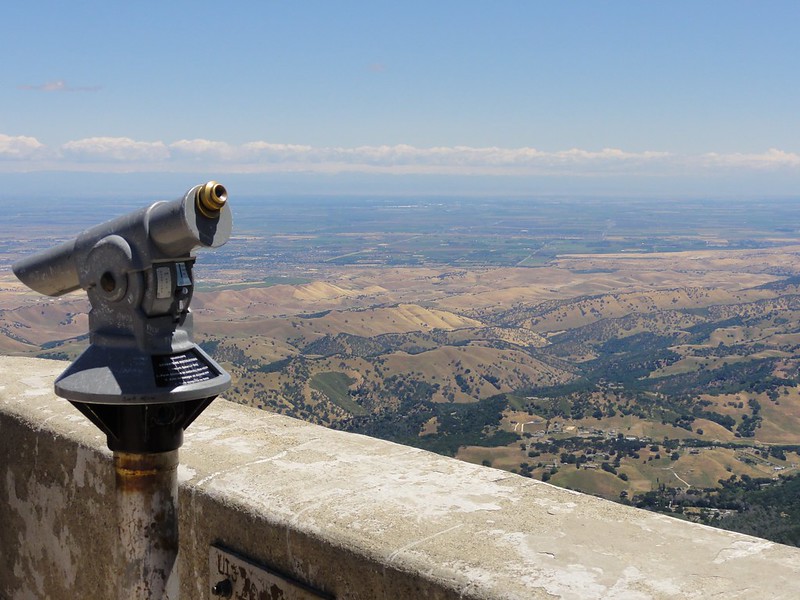
There are 520 miles of hiking, mountain biking, and equestrian trails inside Mount Diablo State Park. This 3,849-foot peak looms over the Bay Area and is visible from all over the region.
The summit of the mountain, can be reached via car. There is a visitors center with an observation deck that offers great views of the Bay Area. Oddly enough, the actual peak is housed inside the building and can be accessed via a circular staircase.
One of the most popular spots for families to visit on Mount Diablo is Rock City. It’s fun to scramble around in the the sandstone caves and climbing atop big boulders.
Mount Diablo is a US National Natural Landmark and California Historical Landmark no. 905.
43. Carrizo Plain Wildflowers

Tucked into the southeastern portion of San Louis Obispo County is the largest native grassland in California, Carrizo Plain National Monument. It is remote, wild, and one of the best places to enjoy wildflowers in the entire country, especially during a super bloom.
Carrizo Plain has been called “California’s Serengeti” because it is home to more endangered species than any other part of the state. Animals include the California condor, San Juaquin kit fox, pronghorn antelope, deer, and Tule elk.
The landscape and biology of the region is very similar to what the Central Valley looked like before agriculture took over.
44. McWay Falls
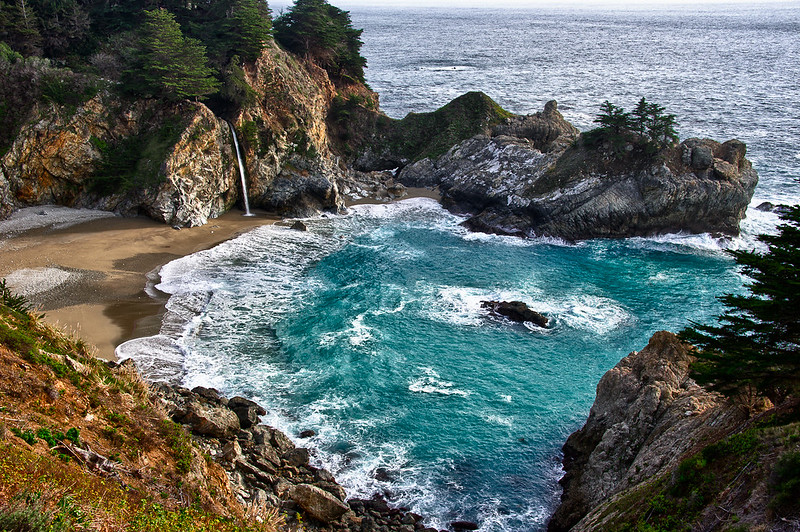
An 80-foot waterfall cascading onto a deserted beach on the Big Sur Coast. Do I really need to say anything else? McWay Falls is located in Julia Pfeiffer Burns State Park, and is certainly one of the most beautiful scenes in all of California.
The falls are visible from Highway 1, but it is safer to park inside the state park and take the short, 1/2-mile trail to the falls overlook.
45. Skunk Train
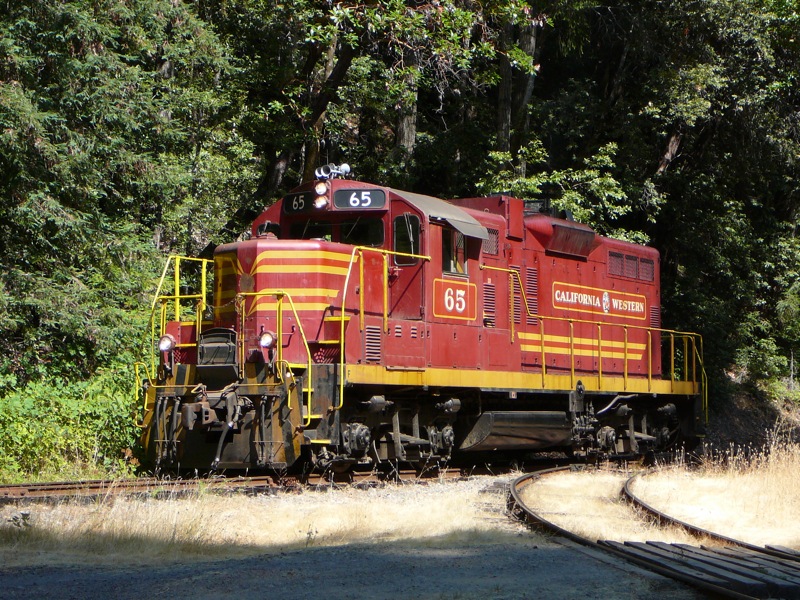
The Skunk Train is a legend of the Mendocino Coast. Formerly known as the California Western Railroad, it is a popular tourist destination for those looking to enjoy the scenic redwood forest.
It runs from both Fort Bragg and Willits and the track cross over 30 bridges and trestles as well as two deep mountain tunnels. The railroad was first founded in 1885 as a way of making lumber transportation easier.
It was nicknamed “Skunk Train” because of the pungent odor the motorcars from the 1920’s expelled.
In addition to a train tour, visitors can also opt to go on a railbike tour. These bikes are electric and virtually silent, allowing you to soak in the beauty of the region. The guided tour includes a stop at Glen Bair Junction for a picnic.
46. Disneyland
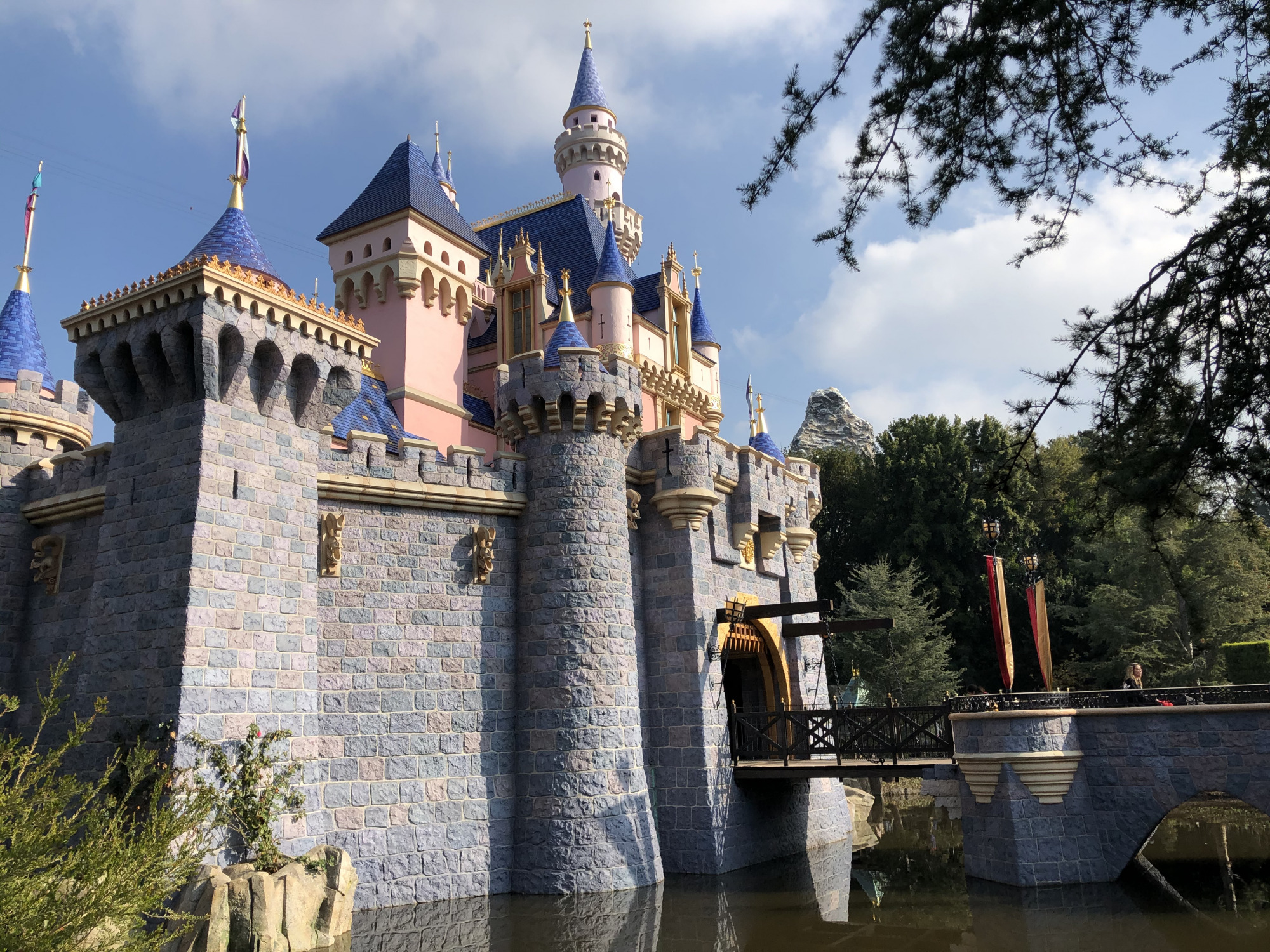
The most popular attraction in all of California is Disneyland. It was founded in 1955 and since then, has only gained in popularity. Over 18 million people visit Disneyland resort each year.
The best time to visit Disneyland (in my humble opinion) is during the first two weeks in December. The park is fully decked out for the holidays but the Christmas crowds haven’t showed up yet. Plus the weather is usually quite pleasant.
I also really enjoy visiting the parks when the California Food and Wine Festival is going on at Disney California Adventure. The food and drink offerings are quite tasty, and the Sip and Savor Pass is a great way to sample the festival offerings in between rides.
47. Universal Studios

Universal Studios is another one of those California landmarks that is also a theme park. The movie studio was founded in 1915 , during the silent movie era. Even then, the studio was open for tours. Admission was a quarter and included lunch! The first tram rides were given in 1964.
The first ride that wasn’t a part of the studio tour came about in 1991 and was ET-themed. Today there are nine rides, seven shows, a play area, and the ever-popular 60-minute studio tour to enjoy.
One of the most popular areas in the parks is The Wizarding World of Harry Potter which brings the famous book and movie franchise to life.
48. San Diego Zoo

The San Diego Zoo is one of the most famous and beloved zoos in the world. It is home to over 3,700 animals representing more than 650 species. It was started with animals left abandoned in their exhibits from the 1915 Panama-California Exposition.
In addition to world class exhibits housing animal from around the world, the zoo is also a wonderland for plant enthusiasts. The zoo grows over 700,000 exotic plants. The landscaping often reflects the environment that the animals originate from.
Highlights include Elephant Odyssey, Monkey Trails, Polar Bear Plunge, The Outback, and the new Africa Rocks exhibit.
49. Lake Tahoe

Straddling the California/Nevada border, Lake Tahoe is the jewel of the Sierras. It is the largest alpine lake in North America and a playground for skiers, hikers, and water enthusiasts alike.
South Lake Tahoe sees over 400 inches of snow per year on average, resulting in world-class skiing conditions. The lake itself is incredibly clean and nearly as pure as drinking water!
It is 1,644 feet deep at its deepest point, and if it was drained it contains enough water to cover a flat space the size of California in 14 inches of water!
50. Fern Canyon

If you want to know what it is like to be immersed in a scene from Jurassic Park, head to Fern Canyon. Jurassic Park 2: The Lost World was filmed in this special spot. The canyon is located inside of Prairie Creek Redwoods State Park, in the heart of redwood country.
Walking into Fern Canyon you will be surrounded by a 50-foot fortress of walls, covered in ferns. It is lush and shady, with a creek running through. During the summer months, wooden slats act as footbridges to help keep your shoes dry.
Keep your eyes out for elk, which frequent the beach and fields near Fern Canyon.
51. Cabazon Dinosaurs

If you have ever driven west on Interstate 10 towards Palm Springs, you have likely seen two massive dinosaurs hanging out by the side of the highway.
150-foot-long Dinny- an apatosaurus- and Mr. Rex, his 65-foot T-Rex companion were the brainchild of Claude Bell, a former Knotts Berry Farm artist and sand sculptor. He built them to attract customers to his Wheel Inn Cafe,
The dinosaurs gained quite a bit of notoriety after appearing in Pee Wee’s Big Adventure in 1985. You climb through the T-Rex’s mouth just like Pee Wee Herman!
52. The Original In-n-Out in Baldwin Park
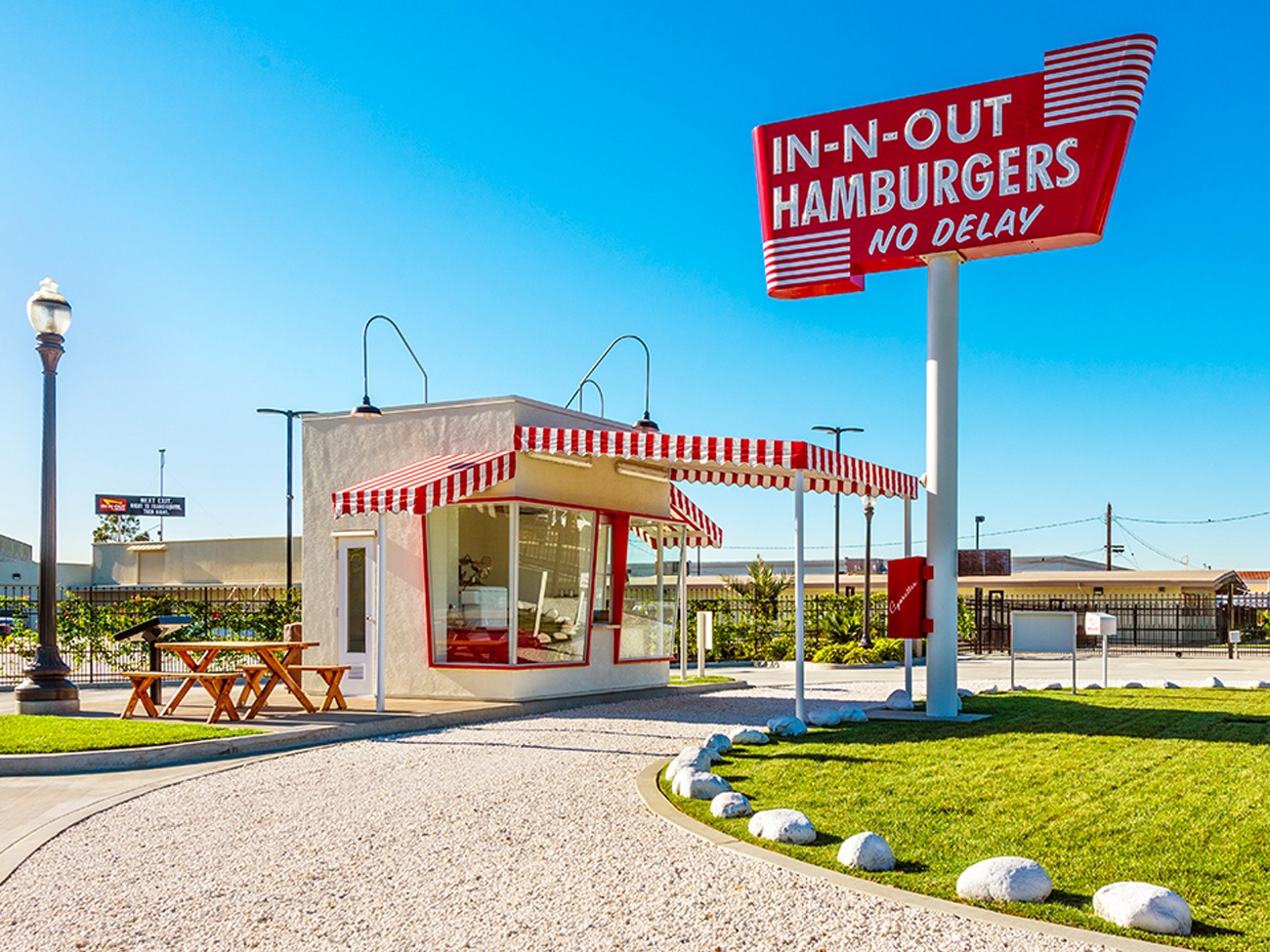
In-N-Out is a California institution. Sure, Mc Donald’s started in California as well, but us lifelong Californians have pledged our allegiance to In-N-Out. So what is the reason a long line is omnipresent at every In-n-Out drive thru? Simple answer- their hamburgers are the best!
We all have our favorite things to order from the secret menu – I like the double meat animal style with fries well done- and the simplicity and consistency of the food brings us back again and again.
Sadly, the original In-N-Out was torn down to make room for Interstate 10. You can visit a replica of the first In-N-Out in Baldwin Park. It is a great place to get pictures. An actual working In-N-Out is on the other side of the freeway. In addition to selling those amazing hamburgers, it also sells souvenirs.
53. Vasquez Rocks
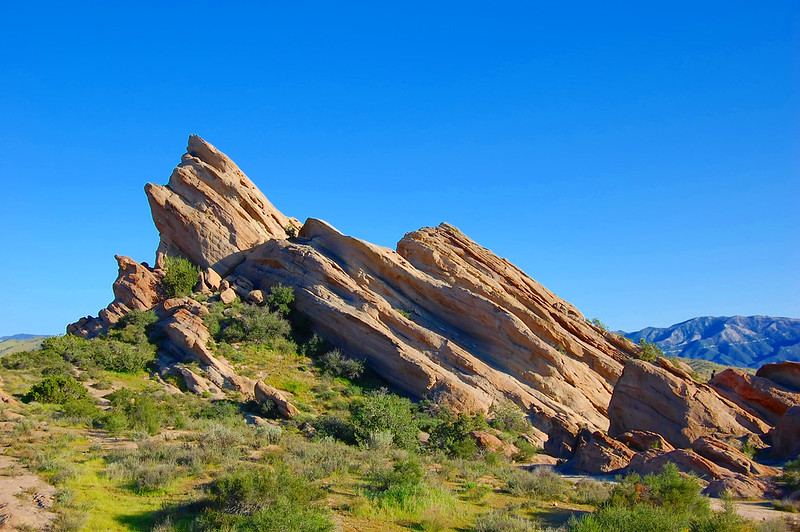
Located off the 14 freeway in near Aqua Dulce, the Vasquez Rocks are a unusual-looking rock formation best known for being a popular filming location for several movies and tv shows. The rocks were named after Tiburcio Vasquez, a bandit who hid from law enforcement in the rocks.
It is probably best known for being featured in several episodes of Star Trek, but Big Bang Theory, Blazing Saddles, The Flintstones movie, and even Bill & Ted’s Bogus Journey have all featured scenes here.
In addition to tv and film, commercials and even music videos have been shot at Vasquez Rocks. Eddie Money, Radiohead, and Michael Jackson are just a few of the musicians who have shot videos there.
Vasquez Rocks was added to the National Register of Historic Places in 1972.
54. Queen Mary

Long Beach is well known for its port which is a popular spot for cruise ship embarkations and its most famous permanent resident is the Queen Mary. Today, the Queen Mary is a hotel and attraction, but in its heyday, it made 1001 transatlantic crossings.
The Queen Mary is larger than the Titanic and was considered to be the finest ocean liner of its time. Fred Astaire, Elizabeth Taylor, Bob Hope, Audrey Hepburn, Winston Churchill, Dwight Eisenhower, and Queen Mary herself have all sailed on the famous ship.
The Queen Mary is said to be haunted. Several prisoners of war died in the lower decks, and there are rumors that former passengers and crew haunt the ship as well.
Today visitors can choose from several different tours, watch a movie in the 4D theater, view a replica of the Queen Mary made from 250,000 LEGO bricks, eat at the onboard restaurants, or stay in one of the rooms.
The RMS Quuen Mary was added to the National Register of Historic Places in 1993.
55. The World’s Tallest Thermometer

If you have driven from Southern California to Vegas along Interstate 15, you have surely seen the famous thermometer in Baker. It is the world’s largest thermometer, after all!
It was built in 1991 and stands at a height of 134 feet to commemorate the record-setting temperature that was recorded in nearby Death Valley in 1913. There is a gift shop at its base where you can purchase a variety of thermometer-themed souvenirs.
56. Madonna Inn
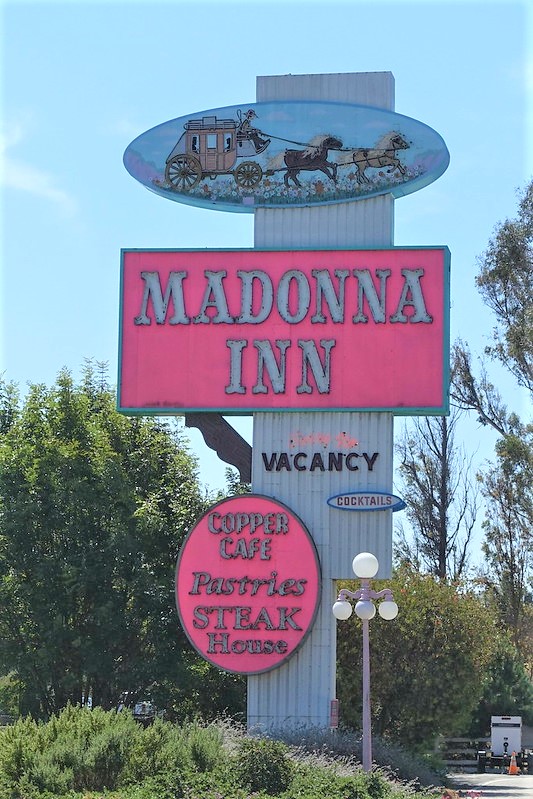
The Madonna Inn is a famous hotel that sits along Highway 101 in San Luis Obispo. This California landmark was built by Alex Madonna and his wife, and it well known for having 109 uniquely-themed guest rooms.
The exterior of the building has a Swiss Alps style. The interior common areas are ornately decorated, with plenty of carnation pink to go around.
Rooms come in all sorts of themes such as Caveman, Jungle Rock, Pioneer America, Antique Cars, and Old Mexico. Several of the suites have rock waterfall showers.
Even if you don’t stay at the Madonna Inn, it is still worthy of a pit stop. There is a famous rock waterfall urinal in the men’s bathroom in the lobby.
57. Bubblegum Alley
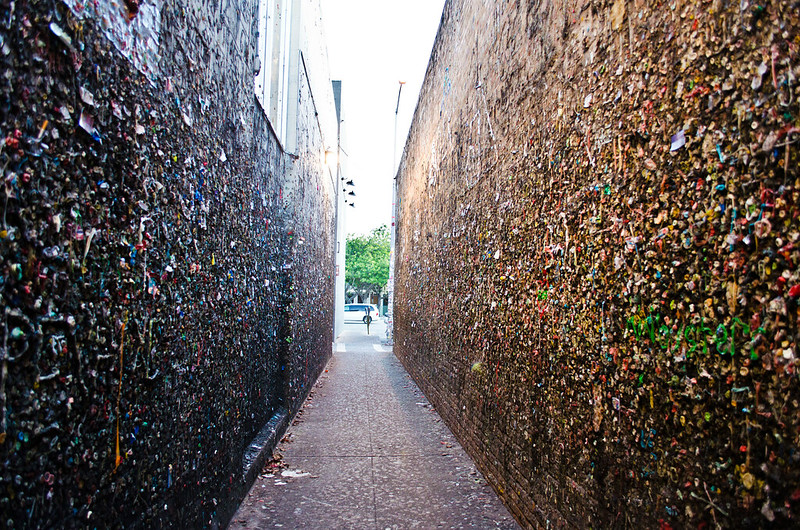
Bubblegum Alley is easily the grossest California landmark on our list. It is located in downtown San Louis Obispo and the walls of this narrow alley are literally covered in people’s old chewing gum. If you are so inclined, you can add to the display. I think I have said enough…
58. Lombard Street
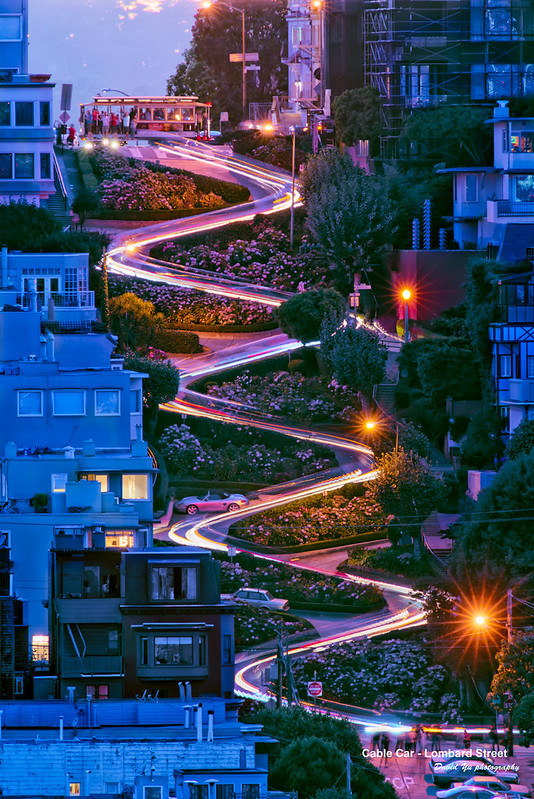
The most famous street in all of San Francisco is crooked Lombard Street. It is known as the most crooked street in the world, but that title really goes to Vermont Street, also in San Francisco.
Still, the 600-foot stretch of Lombard has eight turns and the lovely hydrangeas planted in between curves make it quite photogenic.
Why all the curves? Well, the street is steep and back in the 1920’s cars didn’t have the best braking systems, so the curves were added for safety. It became a one way street (downhill) in the 1930s to further improve the safety of the street.
59. Balboa Park
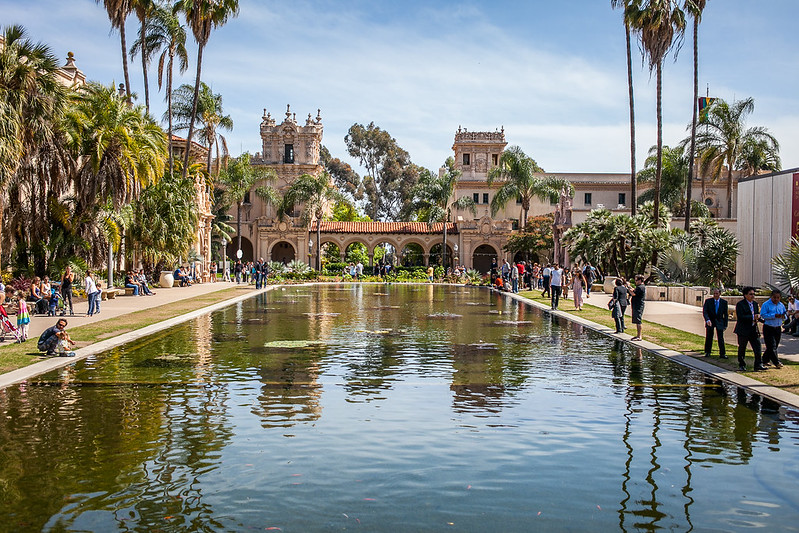
Balboa Park is San Diego’s version of Central Park but it is almost twice the size! It is home to gardens, the Morley Field Sports Complex, theaters, museums, and the San Diego Zoo. Visiting the park is an absolute “must” for any tourist but locals love and use the park regularly as well.
Much of the design and aesthetics of the park is a result of the park hosting the 1915 Panama-California Exposition. Another interesting tidbit about this parks historic past- Balboa Park was used as barracks and training grounds in both World War I and World War II.
Balboa Park became a National Landmark in 1977.
60. Hotel Del Coronado

Hotel Del Coronado is an architectural icon on Coronado Island. Built in 1888, it is one of the few remaining wooden Victorian beach resorts, which were quite popular near the turn of the century. It has hosted countless celebrities, as well a multiple presidents and even royalty!
The Hotel Del sits on Coronado Beach. This beautiful beach has made several lists highlighting the best beaches in the United States.
My favorite time to visit Hotel Del Coronado is during the holiday season when the resort puts up an outdoor skating rink right next to the beach!
Hotel Del Coronado became a National Landmark in 1977.
61. La Brea Tar Pits

More than 3.5 million fossils have been discovered at the La Brea Tar Pits, where asphalt has bubbled up to the surface since the last Ice Age! Out of those 3.5 million fossils, 600 species have been found, including dire wolves, massive lions, huge sloths, and towering mammoths.
Scientists are working to study and uncover more and more fossils on a daily basis. You can watch them at work inside the Page Museum, which showcases a variety of fossils and information onsite.
While there have been plenty of big animals found inside the asphalt, there has only been one human found. She was discovered way back in 1914 and her remains were over 9,000 years old!
Hancock Park La Brea is California Historical Landmark no. 170 and a US National Natural Landmark.
62. Cannery Row
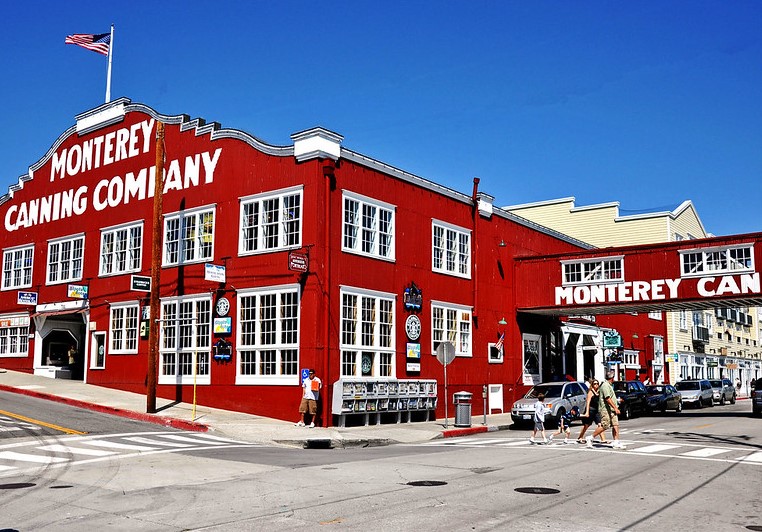
Monterey’s Cannery Row was made famous by the famous novel, Cannery Row, by John Steinbeck. At that time, it was the “Sardine Capitol of the World”. The canned sardines were especially popular during World War I and II.
The last cannery closed in 1973 and today, it is home to Monterey’s most popular tourist attraction, the Monterey Bay Aquarium. There are several restaurants, hotels, and shops housed in former cannery buildings as well.
63. Joshua Tree National Park

With its towering boulders, diverse desert life, and iconic namesake trees, Joshua Tree National Park is a California landmark everyone should see.
My favorite time to visit Joshua Tree National Park is during a wildflower bloom after a wet winter when the desert comes alive with color. Scrambling on boulders is a favorite activity and Hidden Valley is a great spot to climb and scramble around.
We have put together an article which will help you plan you day at Joshua Tree National Park that you will won’t want to miss.
Fun fact: The cover for U2’s famous album, The Joshua Tree, was actually shot in Darwin, California about 200 miles away!
64. Pier 39
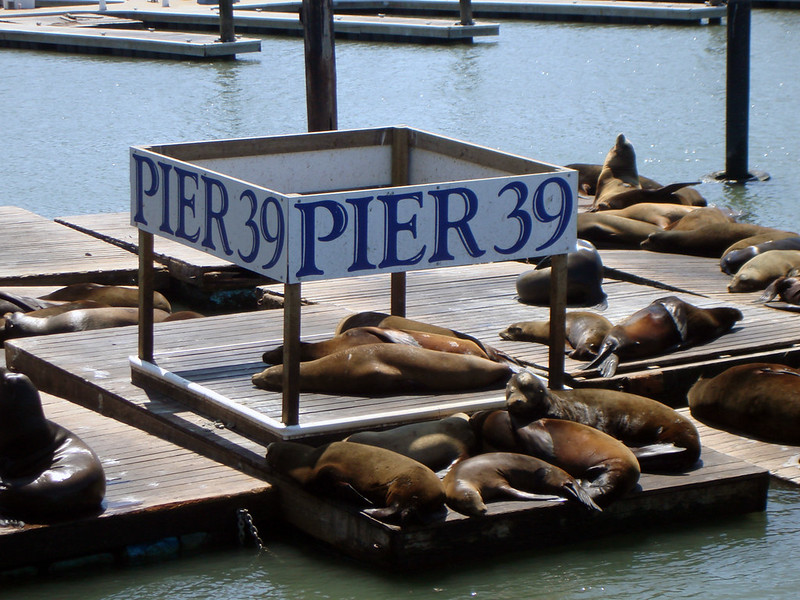
Easily the most touristy spot in all of San Francisco, Pier 39 is one of the places you just have to visit at least once in order to check it off the California bucket list.
Much of the pier is filled with tourist shops and a couple restaurants, but you really want to visit Pier 39 to see the sea lions.
I have spent at least 30 minutes at a time watching those hilarious sea lions and laughing at their hijinks. They continuously fight over the same dock, even though there are plenty of surrounding docks that are unoccupied! They are noisy, boisterous, and endlessly entertaining.
65. Grauman’s Chinese Theatre
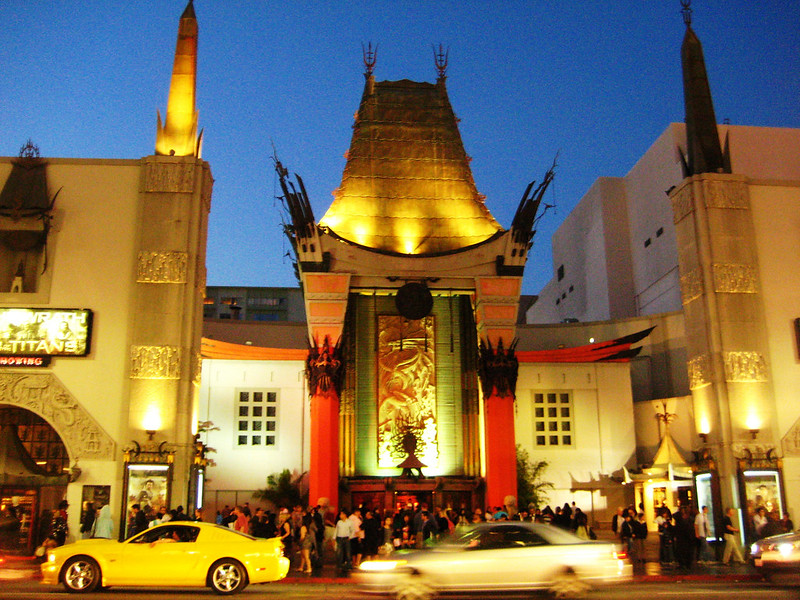
There are so many great historic theatres in Hollywood, but the one that is probably most famous is Grauman’s Chinese Theater because of the handprints, footprints, and signatures of several stars that are out front.
It has gone through several name changes over the years (technically it is currently the TCL Chinese Theatre) but since Sid Grauman built the theatre, that is the name that most people tend to know it by.
The theatre has been the site of several movie premiers, including Breakfast at Tiffany’s, Mary Poppins, and Star Wars. And while it is always fun to stand where movie stars once stood, it is far more fun to compare hands with over 200 icons like Marilyn Monroe, John Wayne, Eddie Murphy, Tom Hanks, and Whoopi Goldberg.
Grauman’s Chinese Theatre is a Los Angeles Historic Cultural Monument.
66. Drive-Thru Trees
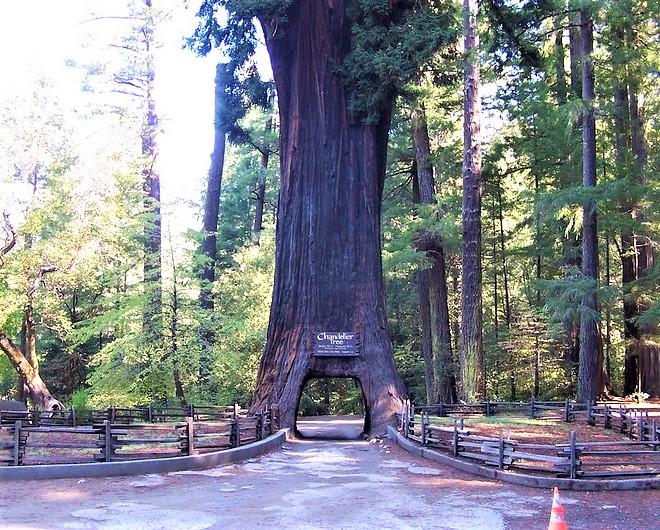
Only in California do the trees grow so big that you can drive right through them! There are three giants redwoods up by Eureka which have had holes big enough to fit a car carved into them.
The Shrine Tree is 50 miles south of Eureka on the Avenue of Giants. The hole in this tree was mostly carved by Mother Nature, which makes it all the more impressive.
The Chandelier Tree is in Leggett and its opening is wide enough to allow some larger vehicles to pass through. Unlike the Shrine Tree, which is closed in the winter, the Chandelier Tree is open every day except Thanksgiving and Christmas.
The Klamath Tree is close to Redwood National Park near the Klamath River Bridge. There is a small gift shop and picnic tables nearby.
67. Glass Beach
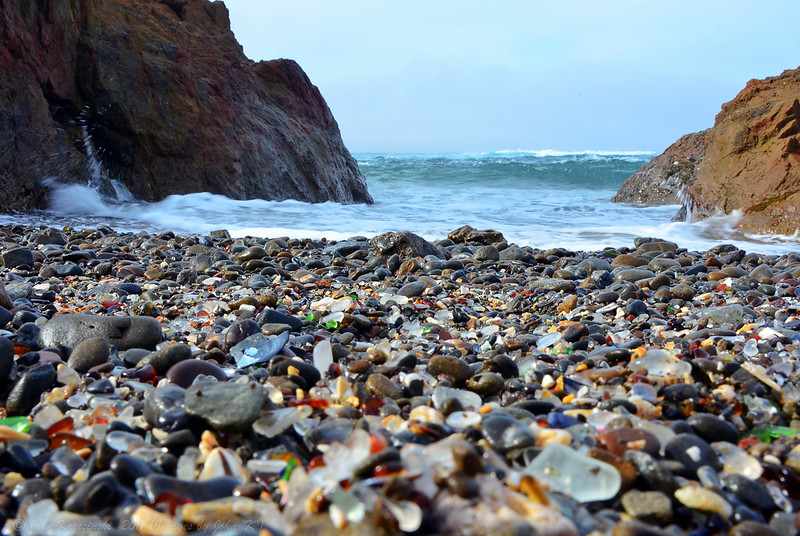
They say one man’s trash is another man’s treasure. Well, that is literally the case at Glass Beach in Fort Bragg! The glass pebbles scattered across the beach are the remnants of when the beach was used as a dump in the 1950s and 60s.
There are actually three “glass beaches” in Fort Bragg, but the third and most recent site is the most well known. Unfortunately, because people keep collecting the sea glass they find, the sea glass is rapidly diminishing from the beach. So visit sooner rather than later, and leave the glass at the beach.
68. Salton Sea
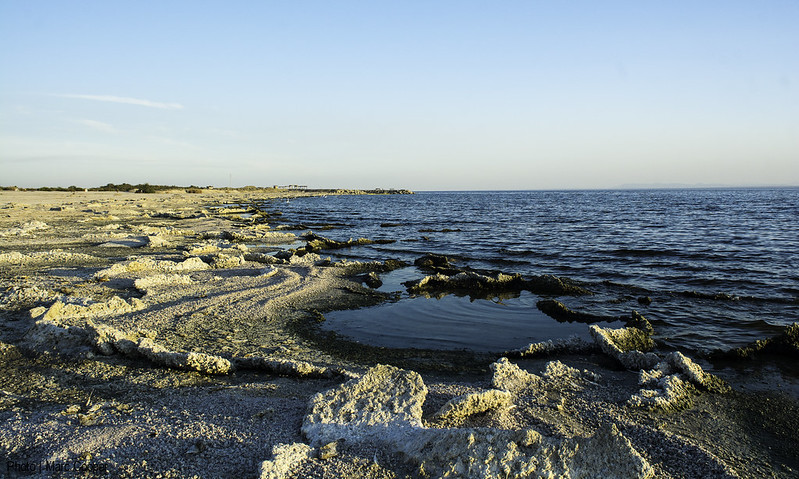
The Salton Sea is a weird place. It is the largest lake in California, but it has only been around since 1905. During that year, the Colorado River flooded through farm irrigation channels in the Imperial Valley, forming the lake.
The Salton Sea quickly became a big tourist destination. It had a yacht club, golf course, marina, and was a popular destination for Hollywood stars like Frank Sinatra. Over 30,000 homes were built near the lake. By the 1980’s the towns along the lake had become ghost towns.
Agricultural runoff from the Imperial Valley brought too much salt and pesticides into the lake. Massive fish die offs have occurred, due to lack of oxygen and too much salt. The Salton Sea is now 50% saltier than the ocean and shrinking at a rate of about 3 % per year.
Today, visitors enjoy bird watching, fishing for tilapia, and checking out the remnants of the thriving tourist towns that used to be.
69. Devils Postpile National Monument
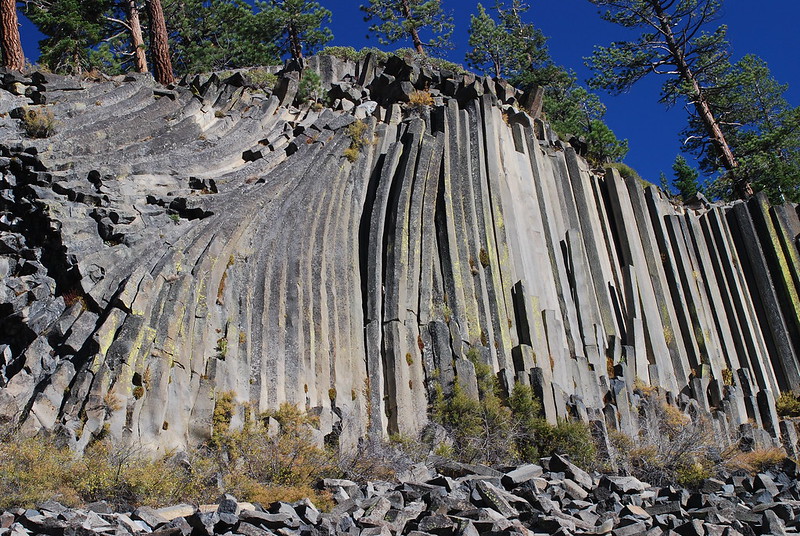
Another weird but natural monument in California is Devils Postpile National Monument near the town of Mammoth Lakes. It looks tall columns of rock were stacked upright by some supernatural being but in reality, this columnar basalt stack was caused by cooling lava 10,000 years ago.
During the summer, visitors must take a shuttle from the Mammoth Mountain Adventure Center to access the monument. Head two miles further down the trail and you will come across 100-foot Rainbow Falls.
On sunny days, the mist reflects rainbows near the base of the falls, giving the waterfall it’s colorful name.
70. Carlsbad Flower Fields

For those living in the far southern reaches of coastal California, the Carlsbad Flower Fields are a welcome site along Interstate 5 every spring.
Thirteen different varieties of Ranunculus are planted each year, resulting in over 500 million flowers and 10 weeks of color!
The fields are open from March 1- May 10 each year. There are wagon rides, several themed gardens, and poinsettia and orchid greenhouses to enjoy. Bring your camera!
71. Venice Canals

Did you know that California has its own version of the famed Venice canals? These man-made canals were put in by Abbot Kinney in 1905 for his Venice of America housing development.
Originally there were 13 canals, but the popularity of the automobile and the need for roads in the area meant some of the canals needed to be drained and paved over.
Today there are six beautiful canals to enjoy. The canals are a popular spot for walking, kayaking, and paddle boarding. Nearby Venice Beach is a quirky spot filed with funky shops and entertaining street performers.
The Venice Canals Historic District was added to the National Register of Historic Places in 1982.
72. San Francisco Cable Cars
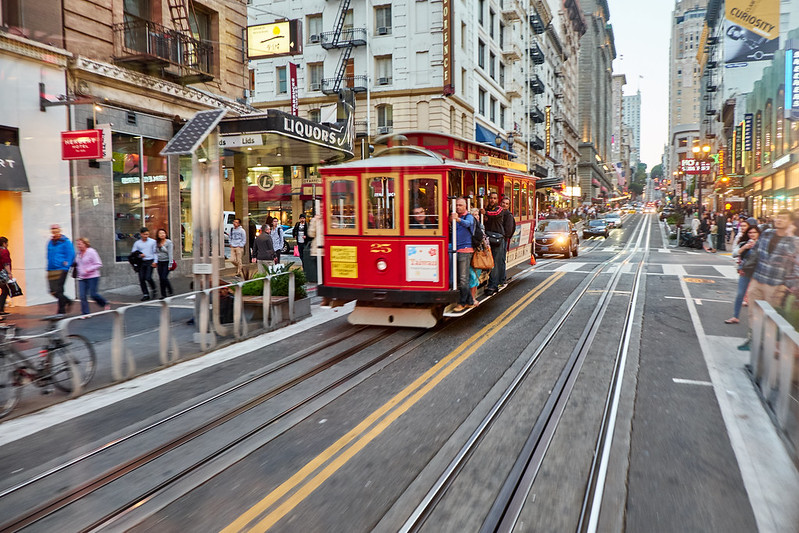
Cable cars have been a part of the San Francisco landscape since 1873. There were over 600 cable cars in operation until the famed 1906 earthquake. Street cars replaced 500 of the cable cars during the city’s recovery.
Today, San Francisco is down to 40 cable cars but they still are an important part of the city’s identity. They run on Powell Street and California Street, and are mostly used by tourists these days.
The San Francisco Cable Cars are US National Historic Landmarks and listed on the National Register of Historic Places. They are the only moving National Landmark.
73. Circus Trees of Gilroy Gardens

Axel Erlandson turned tree grafting into an artform when he created his famed Circus Trees. He carefully shaped trees into basket weaves, hearts, rings, and many other designs that have to been seen to be believed.
By 1957, he had created more than 70 amazingly-shaped trees and was featured in Ripley’s Believe it or Not and Life Magazine.
Erlandson passed away in 1964 and there have been several owners of the Circus Trees since. Even Disney tried to purchase the trees at one point, but the price was too high.
In 1985, 29 of the remaining trees were moved to Gilroy Gardens, a theme park and botanical garden. Today, 25 of the incredible trees are still alive.
74. Palm Springs Windmills
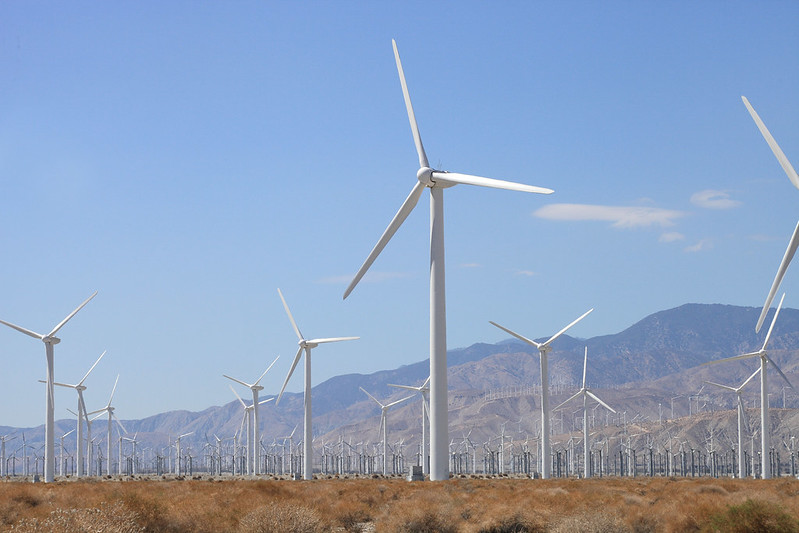
There are several windfarms in California. The most famous is the windfarm just outside of Palm Springs in the San Gorgonio Pass off Interstate 10.
There are about 3,000 windmills in this windfarm that has been an “we’re almost there!” signal for travelers from LA metro heading towards a weekend of fun and sun in the Coachella Valley. Together, they can power up to 300,00 homes! It was the first commercial wind farm in the United States.
Self-guided bike or driving tours are available.
75. Pea Soup Andersen’s

From one windmill to the next, the last of our California landmarks is a roadside restaurant that is well known for it’s billboards and split pea soup.
This roadside restaurant has been feeding travelers since 1924 at its original location in Beullton, next to Highway 101. It was founded by Danish immigrant, Anton Andersen, and his wife Juliette. They opened a second location in Santa Nella, off Interstate 5, in 1976.
Important update: The Buellton location closed suddenly in January of 2024. Santa Nella is still open. There is hope that new owners will reopen the Buellton location but the future status is still TBD.
During peak road trip season, Pea Soup Andersen’s in Buellton goes through 500-600 gallons of pea soup per day! Here is the recipe so you can make their famed pea soup at home.
